|
Victoria's Giant Trees.
Weekly times 1936. A reader asks for the facts concerning Victoria's giant trees in the Cumberland Valley. The area is timbered chiefly with white mountain as ( Eucalyptus regnans ), which on this site attains gigantic size. A square mile of this forest is perpetually reserved against timber utilization. The following details have regard to a one acre plot from which undergrowth has been removed:- Number of trees, 27: volume of stemwood, 21,567 cub. ft: average height of trees, 266 ft., average girth ( 10 ft. from ground level ) 13.3 ft, highest tree, 301 ft. In this forest type growth is more rapid and more luxuriant than in any other Victorian forest. The dense undergrowth which is such a feature of this stand consists of hazel, sassafras, beech, blackwood and musk, to mention only a few of the characteristic species. The Cumberland forms part of a State forest which covers 350,000 acres. State Party Marooned. Trafalgar and Yarragon Times Friday 8th February 1918.
Tourist Hut Gives Shelter. Under the above heading the Herald on Monday last says:- When the storm broke on Saturday a Parliamentary and departmental party led by Mr. Barnes, M.L.A., which was returning on horseback from a trip to the head of the Yarra to inspect the district timber resources took shelter in the tourist hut near Yarra Falls. "The rain fell in bucketsfull", said one member of the party today in describing his experience. "Men and horse soon looked as if they had been wading through a stream. Our boots were full of water. When we reached the tourist hut we had to strip off our clothes and dry them at a fire. While our clothes dried we had to be content with less raiment than is ordinarily worn in the busy haunts. We had a Railway Department photographer with us but he refrained from snapshoting us as we wore rags and other coverings, which are stored at the hut. We stayed all Saturday night at the hut, and left on Sunday morning." The party, in addition to Mr. Barnes consisted of Mr. M. Hannah, M.L.A. vice-chairman, and members of the New Industries Institute.
Healesville and Yarra Glen Guardian (Vic. : 1900 - 1942), Saturday 26 January 1907, page 2
A Visit to the Yarra Falls. By F..G. A. BARNARD. To many the whereabouts of the Yarra Falls is almost as great an enigma as tle North Pole. They are said to exist at the sources of the Yarra, but what direction to take or how to get there is known to very few. Consequently a few notes from one who was fortunate enough to be one of a party of tourists, who starting out from Kew with the hope of reaching the much talked of Yarra Falls, succeeded in doing so may be of service to others who think of venturing into that almost untrodden part of Victoria. On looking at a map of Victoria it will be noticed that the County of Evelyn runs to a point towards the south-east. Now almost in the extremity of this point are situated the Yarra Falls. So far for locality; now, how to get there. Train to Warburton, coach to Yarra bridge, and thence horseback is certainly the most expeditious, but we decided to be independent of every body and so loaded a two-horse van with our camping equipment, provisions, etc., and took to the road. Leaving Kew about 8 a m. on a Wednesday morning, we bowled merrily along, two of the party ridingbicycles, bicycles, through Box Hill, Mitcham, Ringwood, etc., admiring the many views of distant mountains obtainable from the White Horse road, until about midday we reached a favorite camping ground, the ti-tree sheltered banks of Brushy Creek. Here we had our first meal in the open, and gave the horses a welcome rest. Two hours passed quickly by, and we were once more on the road. The steep hill at the Black Springs caused us to slacken our pace a bit, but only to give us more time to admire the surrounding country. As we passed through Lilydale the weekly half-holiday was being observed, so we had the Main street almost to onrselves. Here a pleasant word or two was passed with an old friend, the postmaster, and we were wished good luck on our journey. About two miles further the Warburton road was taken, and found to be in fair order. Everywhere were signs of the prevailing industry of the district-fruitgrowing-and as we approached Wandin station and the adjacent jam factory the pleasant odour of raspberries- filled the air. Our road led us up-hill and down dale through Seville, past the entrance to the Killara Estate, until the shades of evening told us it was time to think about a camping place for the night. The Woori Yallock Creek was close at hand, and having done some 30 miles for the day, we pulled up on the side of the road and soon had a fire lighted and the billy boiling. Our tents were barely fixed before the twilight departed, and then we devoted our attention to attempts to secure a few blackfish for our next morning's meal, but the result was not equal to the efforts made. The night passed slowly as most first nights in camp do, and we were up next morning- With the first sounds of the magpies and the jackasses. Breakfast despatched and our van repacked, we got under way and were soon climbing the hill past the Woori Yallock hotel and store, looking just the same as it did when I passed it in the old coaching days twenty years before. The roads were showing signs of wear, and it was not long before we were in trouble, and had to put our shoulders to the wheel in real earnest. However, a friendly teamster came to our assistance, and with the aid of his horse pulled us out of our first difficulty, and ere long IIoddle's Creek was crossed, and the singularly named hamlet of Launching Place came in view. Here the road, railway and river make a very picturesque combination, and crossing the bridge we pulled up under the shade of some trees for our midday lunch. This was our first acquaintance with the Yarra, and for the next fifty miles we were never many yards from its crystal waters. After lunch a start was made for Warburton, but the bad and dusty road through Yarra Junction warned us that we must have more horse power if we desired to get to our destination, and so much time was spent in hiring horses and buying a few necessary articles we found missing in our equipment, that we determined to make the Little Yarra bridge our camping place for the night, having done only eight miles for the day, a great falling off. The day had been warm, but not unpleasant, and as the sun departed the Warburton hills were tinted with a pale purple glow that in a picture would have been called unnatural. A few blackfish were tempted from their native stream by the efforts of our fishermen, and an additional member of our party arrived by the evening train. Early next morning the fresh horses arrived and we set off in great spirits through West Warburton, past Mill grove, where the extent of the timber traffic was to us quite a surprise. Passing along the picturesque bit of road between tha railway and river towards Warburton the dust was found to be terrible and quite destroyed the pleasure of the many beautiful glimpses of the river rush ing by. Sluicing on Scotchman's Creek was evidently not in progress, for the stream was clear as crystal as it gurgled over the stones to join the Yarra close by. Warburton (5 mile) was left about 10.30 a.m., after adding to our stores; the great mass of Donnabuang (4080 feet), the monarch of the Yarra mountains, showing signs of the timber getters' labors, and the Adventist Settlement near Wonwondah bridge soon left behind. A steep hill with trickling streams had to be negotiated, and then pleasantly situated "Sunny dale" came in sight. Just along the river bank, at a gushing stream, we decided to halt and boil the billy Our horses wanted a spell, and we were glad of the opportunity of washing the Warburton dust off our faces. Two hours were pleasantly spent here and then we were once more on our way. Big Pat's Creek, with its tributary, the Mississippi, was passed, also the lonely East Warburton school. Settlement now began to get sparser; our road passed through much un conquered bush. Heading round gullies and crossing creeks, here and there tree ferns appeared, and finally, after about 13 miles' travelling, we reached Starvation Creek, and though the name was somewhat ominous, decided to camp for the night. The creek, a fine stream fringed with ferns, afforded great opportunities for bathing and fishing, which were soon availed of, and a passing traveller, giving us some information about the road for the morrow, made us hopefuL of finishing our drive that day. During the evening two teamsters, with loads of palings drawn by bullocks, arrived, and in the morning considerable interest was created in watching the methods of yoking up the beasts. Saturday morning broke fine and fair, and a couple of hours' drive brought us to Mahon's Creek, 61 miles from town, the last store and post office up the Yarra. On this stage we had passed over the so-called "peninsula," and had had some pretty glimpses of the Yarra as we.wound along its banks. The store was our last chance of replenishing supplies, and was made the most of. Another hour's drive took us to Reefton, now almost deserted, once a busy mining village. At a pretty bend of the river we pulled up for lunch. A bridge crosses the Yarra here, and a track leads up to the Yarra Track, or Marysville to Woodspoint road, some 12 miles distant. Around us were a number of the prickly box, in full flower, and full of insects of various kinds seeking for honey among the blossoms. As we were finishing lunch, a couple of cyclists came along and an offer of tea induced them to stop for a while, when it was found that they also were making for the Falls, so they were persuaded to join our party. Just as were starting again a snake incautiously put in an appearance, and was promptly despatched. We had now a five-mile drive before reaching our destination for the night, but it took us some time, as the road, though not hilly, was very rutty, and required careful driving. The country was very poor, the trees consequently being of only moderate size, while the native heath, pink and white, was still in bloom. At length, about 5 p.m., we crossed the Yarra Bridge and pulled up at M'Veigh's Upper Yarra Hotel, the sole building of the district. The river here was a rushing, shallow stream some 30ft. wide. We made our camp a few yards up the Woodspoint-road on the side of Walshe's Creek, some 66 miles from town. Enquiries were now made as to our chances of getting' to the Falls, still some 18 miles distant, and we were told that trees were down across the track, and there was little hope of getting through with horses. However, we were not to be put off, and next morning (Sunday), after several delays, we got away at 10.30 on the track to Contention Creek, which winds along the southern side of the Yarra, sometimes almost at the water's edge and at other times rising to several hundred feet as it rounds a jutting spur. This part of the journey was done on foot, with our horses carrying packs. Pretty glimpses of the river with its fringing of trees and shrubs were everywhere obtainable. We soon got over the three miles to Alderman's Creek, where another track branches off to the southeast over the ranges to Neerim, in Gippsland, but our route was to follow the Yarra. Fern scenes become frequent, some showing signs of last season's bush fires. At about 8 miles we reached Contention Greek, now the scene of the workings of Bromley's reef, a mine which at present is attracting some attention. A halt was called for lunch and a little time devoted to an inspection of the water wheel, battery, &c. But we had still a long way to go, and bidding the miners goodbye we plunged into the uninhabited country beyond, hoping to get to Falls Creek, eight miles further, that evening, but we were disappointed; the track is often blocked by fallen trees, and this day was no exception. After heading numerous beautiful fern gullies we came to a fine stream irushing down from Mount Horsfall, and saw the first myrtles, or more properly beeches. Perhaps half-a-mile further a fallen tree blocked the track, necessitating so much delay in cutting it through that we decided to camp at a creek close by for the night. And a memorable camp it was, for in the night one of the horses rolled into the creek, and, with great difficulty by the aid of candle light, rescued and got on its feet again, and next morning it had to be got up out to the track again. We still had some three miles to go to reach the junction of Falls Creek and the Yarra, and had barely made a start when the advance party reported another tree down across the track, in such a position as to render the passage of the horses impossible. There was nothing for it but to unpack everything, take on suffi clent provisions for the day, and leave one of the party in charge of the horses and camp equipment. About an hour later we reached the junction just at the level of the river and about 1000 feet above sea level. Here we found the initials of previous visitors cut in a fine sassafras tree, thus making us certain of our position. Leaving some of our baggage here, we started up the steep spur on the other side of the creek so as to get to the head of the falls. The track was very steep and indistinct, but after half an hour's hard work we were rewarded by seeing and hearing the Falls Creek dashing down into a rocky gorge on our right on its way to join the Yarra. Finally the top of the spur was reached at nearly 3000 feet above sea level; further on the track led to the Thompson River and Mt. Baw Baw. A detour to the right brought us to the topmost fall, and a pretty sight it was as the water came dashing down some fifty feet of sloping rock. Our photographers were soon at work and venturing down further into the gorge secured pictures of some of the other leaps. Time would not permit a full exploration of the gorge, which is a mile or so long, the falls in six or seven leaps being about 750 ft. from top to bottom. On the spur we were about 2750 ft. above sea level, but, owing to the timber, could not get an extensive view. The Falls Creek was at one time thought to be the main source of the Yarra, hence the name Yarra Falls, but is now regarded as perhaps its largest tributary near the source. It starts in a high plateau on the northern aide of Mt. Baw Baw, and, as we saw it, is a fine stream, some eight or ten feet wide and a foot deep. Who first saw these falls I have not been able to ascertain, but they were visited by Prof. Kernet in the eighties, and a small party from the Field Naturalists Club reached them via Marysville and the Yarra Track in November, 1801, and secured perhaps the first photographs taken. Since that time few tourists seem to have visited them until Mr. A. J. Campbell, the well-known ornithologist, spent a week there with some friends in December, 1904, and took an extensive series ef views. The first ladies to see the the falls had only been there this Christ mas, while our party of ten claims the record of being the largest party which has yet attempted the trip. The spot will probably be a difficult one to get at for many years to come owing to its distance from main roads, but should the Warburton railway be extended to Yarra Bridge, as is fondly hoped, and a narrow guage line run over the divide to Woods point, then the Falls can be approached along the divide through much better scenery than by the track along theYarra Valley. At any rate the Lands department is now about to improve the present track, and join it to the track to Mt. Baw Baw from Neerim so that visitors can make the round trip if so desired, Baw Baw itself being worth visiting owing to its elevation and striking difference to the surrounding country. After lunch close by the foaming cataract, we retraced our steps, some by the way we had come, others descended still further into the gorge, and picked up the track lower down, and by four o'clock were once more at the junction. Eight miles lay between us and Bromley's Reef, where we intended to camp for the night, as there was no feed for the horses at any other part, so no time was lost in getting back to the horses and packing up for the final stage. Bromley's Reef was reached in time to allow us to put up the tents by daylight, and the miners very hospitably added to the resources of our larder which had become somewhat depleted during the trip. Next morning (Tuesday) the manager of the mine showed the party the underground workings before leaving for Yarra Bridge. Three of the party elected to climb the steep spur on the opposite aide of the river, down which the machinery for the mine had been lowered, and in two miles reached the Woodspoint road about 10 miles from M'Veigh'a, and returned by it to the camp. They were loud in their praises of the fine views obtained from this road, and, though the climb of about 2,500 ft was rather stiff, considered they were amply repaid by the grand outlook over mountain, valley and creek obtainable in every direction. The afternoon was spent in fishing and pre paring for the return journey towards Warburton on the morrow. Wednesday afternoon saw us once more on the road, and, bidding good-bye to the McVeighs, who had been extremely kind to us, we soon left the peaceful locality of Yarra Bridge. A short halt was again made at Reefton, also at McMahon's Creek, and our former camp at Starvation Creek was reached in time for a late lunch. Getting under way again we reached Big Pat's Creek, about 16 miles, at sunset, and .. in the midst of some thick ti-tree pitched our camp for the night. Laaving early in the morning,Warburton was soon reached. Here letters and telegrams awaited some of the party, determining some to return by rail, but as there was no train till the afternoon we kept together until reaching another former camp at the Little Yarra Bridge, where, after lunch, some of us bade good bye for the present to our companions of the past week, and returned by train from Yarra Junction. The others decided to spend a day or two longer In the Cockatoo Creek district and try and improve their fishing records. Taken as a whole the outing was a most interesting one, and though there were certain discomforts in the way of dusty roads, still afterall that is better than rain, of which we had none during the nine days we were travelling. However, for prefer, ence I would advise visitors to make the trip in November, for then, though the roads may be a bit soft, the bush would be gay with wild flowers, and present a better appearance than it does in January. The scenery does not equal that of the Black Spur and Yarra'Track, still there are many beatiful bits of the Yarra as it rushes merrily along between high ranges clothed with trees to the water's edge. Large trees are fairly numerous, and some of the fern scenes passed would be hard to beat, while everywhere there is an abundance of running streams of beautiful water at the service of the traveller or his horses. On a first visit to such a district one is naturally anxious about his travelling capabilities, and whether he is following the right track, so that a second trip with more time at ones disposal would probably reveal many picturesque parts unnoticed on the present journey. Argus (Melbourne, Vic. : 1848 - 1957), Friday 21 July 1911, page 5 UPPER YARRA FALLS. TO THE EDITOR OF THE ARGUS. Sir, Mr. Panton's letter on the discovery of Mount Donna Buang, that appeared in "the Argus" of the lst inst, brought back to me recollections of the time-half a century ago when I was one of the many hardy prospectors who penetrated the dense scrubs and sleep mountain ranges of the Upper Yarra, in search of gold. I have still a vivid recollection of the night -a most uncomfortable one-I passed with Mr. Panton on Queen's Birthday Creek, on May 24, 1866; but I think that gentleman makes an error when he alludes to me as the discoverer of the falls near the head of the river. I am under the impression that they were visited by a party of surveyors in the year 1845. I certainly re-discovered them in 1867, and named the waterfall (there are several) after Mr. Panton. It would be a graceful act to abandon the present namee (Campbell) bestowed on the lower fall, long after my visit, and revert to the original one, as it would keep green the memory of a gentleman who did much to open up the Upper Yarra valley, and develop the mineral and other re sources. Yours, &c., July 19. J. BLACKBURNE. J. BLACKBURN"!':. July 10. Argus (Melbourne, Vic. : 1848 - 1957), Friday 7 July 1911, page 4
DONN BUANG AND THE UPPER YARRA TO THE EDITOR OF THE ARGUS Sir,-In common with many of your readers, I have read with great interest the various references of late to Mount Donna Buang, including Mr. Pantons val- uable note in "The Argus" of 1st inst. I have reason to believe that the paper en titled 'Melbourne's Great Unknown Mount tain', read by the late Professor Kernot before the Royal Geographical Society in Australia on 13th. May 1907 and pub lished in the "Victorian Geographic Journal" volume 25, was the means of directing attention to Donna Buang, which is, to quote the professors words, the highest by hundreds of feet that can be clearly seen from any i lu iii ii non point in our city' He added that it stands out plain and sharp every other day especially when the north wind blows, and without the use of any instruments at all, but simply to naked eye ijt is umbi) Inglui than any of its neighbouring peaks. That it should be unknown shows how little in terest is taken in geography in the commu nity and how few people use their eyes on the wonderful world around them. Mr. Panton refers to another peak named by him "Mount Lexy" which he thinks is identical to that subsequently named by the late professor Kernot "Mount Hors- fall " a name subsequently altered to "Mount Horsfall ". The professor discusses this matter in a paper on "The Upper Yarra", read before the Royal Geographic Society on 14th ApriI, 1908 and published in the "Victorian Geographical Journal Vol. 26, after his lamented death the duty of seeing it through the press having in voled upon myself as then secretary of the society and editor of its journal. In this paper the professor presents that Mr. Panton's "Mount Lexy is f?m miles north-west of the trigonometric station on Mount Baw Baw meaning to say, on the latest government map with up-to date information from recent geo logical surveys, this point is marked Mount Whitelaw. It would appear, therefore that the older name has been overlooked and, unintentionally no doubt, a serious wrong done to our old friend (meaning Mr. Panton), who by his own zeal and labour did such excellent service in the early days. Further, Panton's Queens Birthday Creek has been lost sight of, although a careful comparison of his and later maps renders it almost absolutely certain that it is iden-tical with the present Falls Creek on which occurs the splendid cataract that is the "Glory of Upper Yarra Valley" ' Further on in his paper the professor described the trip in which he named "Mount Hors- fall", which he frequently t??l nu was entirely distinct from "Mount Lexy" and in concluding he advocated lilli r lilli » (a) The restoration of the name Mount Lexy. (b) The restoration of the name "Queen's Birthday Creek " (c) The naming of some prominent peak near the source of the Yarra "Mount Pan- ton," as a memorial of the excellent geo-graphical work done by that gentleman in the district. Professor Kernot added that he would have no objection to the name "Mount Horsfall" being altered to "Mount Panton" if no other suitable peak can be found. (d) The naming of some prominent fea- ture at or near the source of the Yarra after Mr. Robert Hoddle, the first surveyor general of the Port Phillip district, who in 1845 made the first survey towards the head of the Yarra. May I, through you, ask the favourable consideration by the Government of these suggestions. Their adoption would not only a fitting tribute of the good work done in district by Mr. Panton and the late Robert Hoddle, but also a graceful com-pliance with the wishes of the late Professor Kernot, who was undoubtedly one of the most honourable, talented and straight- forward citizens that Victoria has ever possesed, in addition to being amongst her most distinguished civil engineers and Uni-. veristy professors.-Yours, &c., THOMAS WALKER FOWLER. 421 Collin-street, July 3. Photo above near the source of the Yarra River 1909.
A TRIP TO THE UPPER YARRA DISTRICT. (BY "VIATO.") On the morning of the 9th inst. a party of seven, consisting of a councillor (hereafter called " The General"), his two sons (" The Farrier" and "The Baker"), a local chemist (" Dr. Pills") and* his son (" Norme"), a contractor known as "The Champion" (tea drinker), and the son of one of Kew's oldest councillors (known as "Captain Moonlight"), left Kew at 8 P.m. with a caravan drawn by two small horses, and two bicycles, en route to the falls at the source of the Yarra River. Brushy Creek (16 miles) was reached, and a halt was made for lunch, thence through Lilydale to Worri Yallock (32 miles), where the camp was pitched for the night. Fishing was indulged in at night and shooting in the morning. January 10.-A start was made at 8.30, but at Oak Hill (a few miles further on) the hames broke, and a .new pair had to be purchased. Another start was proposed, but one of the horses objected; consequently, the services of a dranght horse were called into requisition, and the whole caravan was safely towed up to the top of this steep hill. Launching Place was reached at 11.30, where the midday meal was disposed of. Onethirty to 2 p.m. was occupied in covering the distance to Yarra Junction, where a halt was made until 4 30 p.m. There negotiations were made for the hire of a pair of heavier horses, which were secured at the exorbitant (save the mark !) fee of 10s per day for two horses, a driver, and the keep of the horses. The party then pushed on to the Little Yarra and camped for the night, and were joined at 9 p.m. by "The Measurer." January 11.-We were met by the driver with the two hired horses, and a start was made at 7.40 a.m., and we passed through Old Warburton, the new township of Hillgrove, and thence along the banks of the Yarra to War burton itself, the present terminus of the railway extension into this part of the state. The scenery here and further along the route is best described by the word, " Grand "-grandeur everywhere. From this point almost to the furthest point of our journey we have the beautiful ever-flowing rapid waters of the Yarra on our left, and steep, precipitous mountains on our right, lifting their heads up into the clouds. Here and there bridges have been thrown across the river to connect the settlers on the far side of the river with civilisation on this. The whole scene is picturesque. The timber trade with this railway station is enormous-timber trains are sprung upon you at nearly every turn of the road, and the cartage from outlying districts by bullock wagons has cut the roads up terribly. For the past two years (so we were informed, and we could readily believe it) no attempt at repairs has been made. The consequence is that from this point on wards wards you have to keep your eyes open continuously for large holes and deep ruts. The balance of the roadway is covered inches deep in dust. Having laid in a further supply of provisions, we pushed on to Sunnydale (3 miles), where we camped for dinner. This spot is as pleasant a one as the eye could rest upon. The river is almost horse-shoe shape, the soil is of a chocolate volcanic origin, planted with English grasses, and the cattle grazing thereon were in prime condition. The beautiful green tinge of the grass, contrasted very strongly with the brown, sunburnt, natural grasses hitherto met with. Having refreshed the inner man and consoled ourselves with a game of crib, we set out for Starvation Creek, where we purposed camping for the night. Some three miles short of our destination we were overtaken by two young men on rather flash horses, from whom we made enquiries as to the distance yet to be covered. They were as deficient in knowledge of the locality (if not more so) as we were ourselves. At the conclusion of our inquiries our "corner man"-mounted on his white charger, wearing blue dungarees and leggings, minus a coat, shirt-sleeves rolled up, and hat well drawn down over his eyes-asked, in sonorous tones, " Have you got any money?" The elder youth laughed, but the younger lad's face blanched, and he edged his horse away quick and lively. Thereafter our corner man was known as "Captain Moonlight." Starvation Creek was reached about 6 p.m., and immediately on passing over the bridge your eyes were drawn to a signboard affixed to a tree, bearing the name, " Starvation Creek." Fas tened on to the sign-board was the dry thigh-bone of a bullock, indicative of miners' results in fossicking for gold at that place. We pitched our camp on the flat, and, after tea, went fishing. At 10 30, when the last of us were retiring for the night, we were attracted by the sound of bullock teams approaching, and, shortly afterwards, two wagons, loaded with 1500 palings each, and drawn by 16 and 14 bullocks respectively, hove in sight. Here, also, the drivers camped for the night, the bullocks being let loose (each with a bell round its neck) to forage as best they may. The bullock drivers had been at work since 5 a.m. They made their bed on some dozen bags of chaff, under a tarpaulin covering, which had been left there by Mr Buller, of the store at McMahon's Creek, three miles further on. Mr Buller is accustomed to leaving half his load at this point on account of the steep hill between Starvation Creek and McMahon's Creek, and so great is the code of honesty in this part that he has never been known to lose a bag. January 12.-Up at 5.30 a m., our usual hour, and after bathing, breakfast, and repairing punctured bicycle tyres, the two cyclists covered the three miles to McMahon's Creek in 25 minutes, notwithstanding the hills and dust. The peculiarity of this dust, viz., powdered schist rock was .that no matter, what its depth you could always ride through it. A similar depth of dust around Kew would invariably bring you to a stand still. At Mr Buller's store at McMahon's Creek we laid in our stock of provisions, as this was the last store on our road, and we had still 26 miles to go and return before replenishing the larder. By 12.30 we reached the old mining town of Reefton (which now consists of two houses), and camped for dinner. Whilst the meat, potatoes, and onions were cooking in the camp oven we adjourned to the river for a swim, but, so strong was the current, that not one of us could make any headway against the stream, and those who swam across made a decided diagonal course. Whilst at dinner, two cyclists rode up. They were the sons of Councillor Wilson, of the Lilydale shire, and were on their way to the Yarra Falls. Their tents, &c., had gone ahead of them in the coach. They had heard of us along the road, and had been keeping their weather eye open. We asked them to join our party, which they readily agreed to do, and right good campmates they were. The elder one is at the training college in Melbouirne, and expects during this year to put in a portion of his time under our worthy friend, Mr McCrae, at the Kew East school. McVeigh's hotel, at Walsh's Creek, was reached at 5 p.m., and our camp was pitched about a quarter of a mile beyond his house, at the junction of the Wood's Point and Clear Creek roads. Owing to the kindness of Mr McVeigh, five of our number (now increased to 11) were able to sleep in a tent he has had permanently erected on the roadside on a wooden floor, and under a bark roof instead of a fly. Here we met Jimmy Clark, the man who cut the track to the Falls, and received full instructions as to the route to be taken. Here two curious incidents were noted. The whole of this portion of the country has been permanently reserved for future water supply purposes for Melbourne, yet Mr McVeigh has the pick of the land, and has erected a large hotel. He has been resident there for nine years, and his house is the only one for miles around. The other incident is a printed notice of the Education department re "compulsory attendance at school." The youngest resident is the proprietor's daughter (about 22 summers), and the nearest state school is a single-roomed paling dwelling fully half way to Warburton. January 13.-After an early breakfast we started to pack our four horses in a peculiarly up-to-date style of our own, and just before starting, at 10.55, a photo was taken of the turnout. It will be interesting to see how they develop. From this point to the Falls Creek (16 miles) a pack track is followed, which for the most part skirts the Yarra. It is good solid plugging following this track up hill and down dale. At first the four horses were led, but "The General" soon became full of "Captain Moonlight's" charger, and practised his 'prentice 'prentice hand at bullock driving, and was successful in soon reducing his steed to a worthy pack-horse. At 2.10 (7 miles) we reached Contention Camp (Bromley's Reef Goldmine), but of this you shall hear more later on. After dinner we caught a few fish, and then pushed on with the intention of camping at Fall's Creek, but at Poverty Bend (3 miles short) we were blocked by fallen timber and had to camp for the night on the track. Bed was sought at 9 p.m. About 11.30 p m. one of our number was awakened by a crashing sound, and on investigation it was found that one of the horses had got loose and had fallen off the track. All hands turned out, and until 2 a.m axes and tomahawks were used in cutting away timber to free the poor brute, who was jambed between two saplings, with his feet hanging over the creek. After two and a-half hours' solid graft we were able to pull the horse clear and roll him into the creek, about 2ft. deep. Then "The General" and "The Champion," with lantern and axe, proceeded to lead the horse along the bed of the creek to the crossing, about 200 yards up, but being blocked by fallen timber, tethered him on the further bank for the night, and repaired to the camp-fire to dry their boots and socks. A billy of tea was soon brewed, and bed once more sought. January 14.-A stir was made at 5.15 a.m., and a reconnoitre being made, it was found necessary to cut a zig-zag track up which to lead the horse. The barometer gave the fall of 47ft. down a 1 in 1 slope. At 9.30 a start was made, the horses being left behind with the driver, as the track was blocked. Falls Creek was reached at 10.30, after passing through a forest of beautiful beach trees, the timber previously being black butt and stringy bark. Here we found the brand of Mr A. J. Campbell, of the Mines department, on a sassafras tree. Mr Campbell gave the height of the Falls Creek as 1760ft. above sea level. Our barometer gave only 1550ft. From this point there is a steady climb of two miles and a-half up the spur, rising over 1000ft. in that distance. Turning to the right we reached the top of the falls at mid-. day, where we had lunch. Four different photos of the falls were taken. Owing to want of time and shortness of provisions we were unable to climb from the top to the bottom-a distance of 700ft. in less than half-a-mile. The sight was one of exceeding grandeur, double falls, single falls, and cascades following one another in quick succession. The country itself was disappointing-trees there certainly were in plenty, but small plant life was rare. Snow lies on these mountains (2800ft. above sea level) for about eight months of the year. The water which soaks into the schist rock, of which the whole of these mountains are composed, freezes, and, expanding, splits the surface stones along their cleavage planes, thus rendering it exceedingly dangerous when climbing in parties. Once a stone is loosened from its bedding, it thunders down the hill and over the precipices (many of them from 50 to 100ft.), and never ceases until the foot of the falls is reached. One should never die of thirst in this country, but animal and bird life are practically an unknown quantity. At 2.10 p.m. we set out on our return picked up our horses at Poverty Bend at 4.15, had afternoon tea, and pushed on to Bromley's Reef and pitched camp at 7.15. January 15.-After breakfast, Mr Victor, the manager of the mine, which is the first opened up in this country, very kindly showed us all that there was to be seen. Two reefs have been discovered. No. 1 gave 4580z. from 130 tons; No. 2, about 150ft. west, 17oz from 15 tons. No. 2 is being worked at present. From the side of the hill a tunnel runs 160ft. west, and then the drive turns up north and south along the reef 130ft., which outcrops on the surface 60ft. above. The stone is run out on the trucks, and then sledged down to the 4-head battery worked by waterpower. The cost from first to last works out at 16s. per ton. From the battery a tunnel is being driven on a grade of 4ft. in 100ft. to intercept the No. 1 reef, which outcrops on the surface 670ft south, and has been opened out to a depth of 130ft, showing a reef 2ft. in thickness, carrying good gold the whole way. This tunnel has already been opened out 490ft., and it is expected that in nine weeks the shaft will be reached. Steel rails are being laid for the tram track in this tunnel, and it is the intention to tunnel across to No. reef, which will mean a considerable reduction in working expenses. The mine has been floated into a company of 30,000 shares at 5s. each, half paid up, and to-day are quoted on the market at 6s. 2d. The Hon. E. Miller is chairman of directors. I believe there is a big future before this district as regards mining. Our camp at McVeigh's was reached at 1.50 p.m , and the rest of the day was devoted to fishing. January 16.-At 10 a.m. a start on the return home was made. We camped for the night at Big Pat's Creek, and reached Little Yarra at 1 p.m. on the 17th. There half the party returned by the night train, the remainder visited the Britannia Falls on the 18th, and on the 19th went up the Cockatoo Creek on a fishing expedition, leaving there on the morning of the 22nd, and arriving in Kew at 5 the same evening. All had a thorough good outing, and the event was carried out on strictly teetotal principles. Trout fishing at Walsh or Walsh's creek Upper Yarra River 1921. McVeigh's or Upper Yarra hotel.1/22/2017 Top drawing Fernshaw. Middle drawing Etta's Glen waterfall. Bottom drawing Snake Creek Morley's track.  Top drawing Louisa's Glen Myrtle gully. Bottom drawing across the dividing range. THE resident of Melbourne, like the people of Sydney,
has no difficulty in finding grand scenery within a few, hours ride of the City ; and the following narration of a trip over the Dividing Range will we are sure be read with great interest : " An outing for holidays being suggested by a friend who has a weakness for the grand and sublime in nature, the question arose where were we to go to ? The Dandenong, You Yangs, Macedon, or the Great Dividing Range ? which should it be I A toss up, and the latter was decided upon. A bright sunny morning found us alert at six o'clock at Jefferson's Hotel, in the small but exceedingly romantic township of Fernshaw, which is situated in a valley on the banks of the river Watts, and surrounded on every side by mountains of very con- siderable elevation, covered with trees of gigantic growth, j the bases of which are interwoven with an undergrowth of ferns, kangaroo, sword and many other grasses, rendering many places utterly impenetrable. As break-fast would not be ready until eight or nine o'clock, we decided on a scramble up to the summit of Mount Romeo, situated on the south side of the town-ship. From this elevation a glimpse of the township through the giant trees, with Mount Mouda in the distance, is a sight not easily to be erased from the memory. The sound of Cobb's coachwheels coming down the Black's Spur, about a mile or more to the eastward, reminds us that it is time to return ; for, putting breakfast out of the question, in all these little country villages the arrival and departure of the coach is the event of the day. We do honours to the culinary department, and then decide for a trip to the eastward until noon. Leaving the village along the Black's Spur Road for about a quarter of a mile, we turn off in the bush to the right on a pack track used by splitters, near the creek, which is named Morley's track and creek. There are many points of interest along this tracknotably the very beautiful fern gullies, then the cross-ing place, which is a tree felled across the creek at the instigation of Mrs. Jefferson, along which visitors may now walk with ease, and extend their explorations to the extent of a few miles beyond. We visit the Three Brothers, or the three giant ferns, as they have been named by the Anglo-Australian Photo. Company, who first discovered and secured an excellent photograph of them. The three giants measure respectively from fifty to sixty feet each in height. We visit many spots along the creek, too numerous to particularise, sometimes climbing up steep pinches to get a glimpse of a gully below, now cutting our way through ferneries to dis-cover a new scene on the river. Gullies were passed through containing ferns of every variety, many of them of prodigious dimensions, hundreds of them being three and four feet thick at the base. Having reached Gold Creek, about four miles from Fernshaw, we retrace om steps along Trasks track until we reach a confluence oi Morley's Creek. The sun had been obscured for many days owing to a continual rain, and had shone out with unusual splendour, hence all insectiferous and animal life was on the move ; great lizards were constantly under one's feet, centipedes were plentiful in the dry fallen timber. Whilst stooping to pick up some curiosity a carpet snake, from four to five feet long, was crawling towards one of our party from under some matted grass at a distance of only a few inches ; we gave chase, anc with some difficulty captured the reptile. In remem brance of the event we named the spot Snake Creek We then visited the Black's Spur, a hill over 3,000 feehigh, to which an excellent road has been made extend ing for three miles before the top is reached. In sonn places the road is very steep ; some idea of its steepnesi may be obtained from the fact that a teamster with si: horses and a loaded dray had taken eight hours to read two miles. The surveyor must have been fond o climbing, ' as a level road could have been surveyec round the brow of the hill near Morley's Creek. Pro bably he followed a track formerly made by the black belonging to the Goulburn tribe, who used to cross tin Dividing range for hunting purposes ; hence it derive< its name of the "Black's Spur." The scenery on tiri mountain is perhaps the best to be seen in the district and well repays the extra effort and trouble of climbing The gullies are grand in the extreme, but many of them although superintended by a forest ranger, are bein: ruthlessly destroyed by splitters. Myrtle Creek take its rise from the summit of the mountain down a cours of precipitous cataracts, falls and glens (Etta's Glen, waterfall named after Miss Jefferson, is the mos notable), but only a few glimpses can be obtained of it romances, as a sturdy bushman with an axe is require to clear a track. Having heard of Big Ben, the larges tree now standing on the range, we decided on crossing the mountain to see it. With considerable difficulty after many scratches, in cutting our way through sword grass and climbing over dead timber, we reached the ol giant, whose age according to calculation must h between 700 and 800 years. It is 350 feet in heigh" and about 56 feet girth around the base. When felled a family of eight could sit comfortably around a lars table on the stump. Probably much larger trees that this exists, but as only a small portion of the district has been explored, they are not known. The beautiful lyre bird is as common in this forest as the blackbii and thrush are in the old country. It is very shy, but easily caught with dogs, who scent the birds and the bark, which seems to affect them with fright, for aft* hearing the dog bark, these lovely creatures will never stir until the sportsman comes up and secures his game The list of game to be found here is too numerous i particularise. Those who are fond of sport; viz., hoi shooting and fishing, cannot do better than put up for week at the Black's Spur ; they will not come away dis appointed. After leaving Big Ben, we cross the ram westward into Broadbent's Gully, and make towards tl Mount Monda track, for the purpose of seeing some < the beauties of the River Watts. There are so mar pretty spots in this rugged river that it is difficult i choose between them. Striking the Mount Monda track we return by way of Contentment Creek until we reach the river, which we are compelled to cross on a fallen tree over a hundred feet long. This spot is known as the Bend of the River at the Mount Monda crossing. Here and there, at intervals of a few hundred .yards, there are small islands in the centre of the stream studded in some cases with but a solitary tree. Salmon trout are plentiful at this part of the river. Steep banks, precipices and dense foliage make up a series of scenes lovely and picturesque. Our illustrations have been selected from some excellent photographs taken by Mr Caire, landscape photographer, of Melbourne, showing some of the places described by our tourist. No. 1 is Fernshaw, from the foot of Mount Monda ; No. 2, Etta's Olen Waterfall ; No. 3, Snake Creek, on Morley's Track ; and No. 4, Louisa's Glen, Myrtle Creek. The Watts River 1890.
The Watts river takes its rise on the Black Spur, and was famous whilst a terra incognita for its black fish. It can be seen at its best at Fernshaw, where it divides itself into two branches, to be afterwards reunited. Some years ago, when the water supply of Melbourne was found to be growing short of its requirements, this river was fixed upon as the most eligible from which to draw a further supply, and the tunnel and other aqueducts necessary to this scheme are now nearly finished. Fernshaw has quite a name amongst tourists and pleasure-seekers; but, as it is necessary to keep the river free from pollution, all the hotels and properties were purchased by Government. Fernshaw is about forty-four miles from Melbourne. Yarra Falls 1909. On the tributary of Falls Creek off the Yarra River. Yarra Ranges National Park.1/18/2017 A Visit to the Yarra Falls. 1909 By F..G. A. BARNARD. To many the whereabouts of the Yarra Falls is almost as great an enigma as tle North Pole. They are said to exist at the sources of the Yarra, but what direction to take or how to get there is known to very few. Consequently a few notes from one who was fortunate enough to be one of a party of tourists, who starting out from Kew with the hope of reaching the much talked of Yarra Falls, succeeded in doing so may be of service to others who think of venturing into that almost untrodden part of Victoria. On looking at a map of Victoria it will be noticed that the County of Evelyn runs to a point towards the south-east. Now almost in the extrem ity of this point are situated the Yarra Falls. So far for locality; now, how to get there. Train to Warburton, coach to Yarra bridge, and thence horseback is certainly the most expeditious, but we decided to be independent of every body and so loaded a two-horse van with our camping equipment, provi sions, etc., and took to the road. Leaving Kew about 8 a m. on a Wednesday morning, we bowled mer rily along, two of the party riding bicycles, through Box Hill, Mitcham, Ringwood, etc., admiring the many views of distant mountains obtainable from the White Horse road, until about midday we reached a favorite camping ground, the ti-tree sheltered banks of Brushy Creek. Here we had our first meal in the open, and gave the horses a welcome rest. Two hours passed quickly by, and we were once more on the road. The steep hill at the Black Springs caused us to slacken our pace a bit, but only to give us more time to admire the surrounding country. As we passed through Lily dale the weekly half-holiday was being observed, so we had the Main street almost to onrselves. Here a pleasant word or two was passed with an old friend, the postmaster, and we were wished good luck on our journey. About two miles further the Warbur ton road was taken, and found to be in fair order. Everywhere were signs of the prevailing industry of the dis trict-fruitgrowing-and as we ap proached Wandin station and the adjacent jam factory the pleasant odour of raspberries- filled the air. Our road led us up-hill and down dale through Seville, past the entrance to the Killara Estate, until the shades of evening told us it was time to think about a camping place for the night. The Woori Yallock Creek was close at hand, and having done some 30 miles for the day, we pulled up on the side of the road and soon had a fire lighted and the billy boiling. Our tents were barely fixed before the twilight de parted, and then we devoted our atten tion to attempts to secure a few black fish for our next morning's meal, but the result was not equal to the efforts made. The night passed slowly as most first nights in camp do, and we were up next morning- With the first sounds of the magpies and the jackasses. Break fast despatched and our van repacked, we got under way and were soon climbing the hill past the Woori Yal lock hotel and store, looking just the same as it did when I passed it in the old coaching days twenty years before. The roads were showing signs of wear, and it was not long before we were in trouble, and had to put our shoulders to the wheel in real earnest. However, a friendly teamster came to our assist ance, and with the aid of his horse pulled us out of our first difficulty, and ere long IIoddle's Creek was crossed, and the singularly named hamlet of Launching Place came in view. Here the road, railway and river make a very picturesque combination, and crossing the bridge we pulled up under the shade of some trees for our midday lunch. This was our first acquaintance with the Yarra, and for the next fifty miles we were never many yards from its crystal waters. After lunch a start was made for Warburton, but the bad and dusty road through Yarra Junction warned us that we must have more horse power if we desired to get to our destination, and so much time was spent in hiring horses and buying a few necessary articles we found mis sing in our equipment, that we deter mined to make the Little Yarra bridge our camping place for the night, having done only eight miles for the day, a great falling off. The day had been warm, but not unpleasant, and as the sun departed the Warburton hills were tinted with a pale purple glow that in a picture would have been called unnatural. A few blackfish were tempted from their native stream by the efforts of our fishermen, and an additional member of our party arrived by the evening train. Early next morning the fresh horses arrived and we set off in great spirits through West Warburton, past Mill grove, where the extent of the timber traffic was to us quite a surprise. Passing along the picturesque bit of road between tha railway and river towards Warburton the dust was found to be terrible and quite destroyed the pleasure of the many beautiful glimpses of the river rush ing by. Sluicing on Scotchman's Creek was evidently not in progress, for the stream was clear as crystal as it gurgled over the stones to join the Yarra close by. Warburton (5 mile) was left about 10.30 a.m., after adding to our stores; the great mass of Donnabuang (4080 feet), the monarch of the Yarra mountains, showing signs of the timber getters' labors, and the Adventist Settlement near Wonwondah bridge soon left behind. A steep hill with trickling streams had to be negotiated, and then pleasantly situated "Sunny dale" came in sight. Just along the river bank, at a gushing stream, we decided to halt and boil the billy Our horses wanted a spell, and we were glad of the opportunity of wash ing the Warburton dust off our faces. Two hours were pleasantly spent here and then we were once more on our way. Big Pat's Creek, with its tributary, the Mississippi, was passed, also the lonely East Warburton school. Settlement now began to get sparser; our road passed through much un conquered bush. Heading round gullies and crossing creeks, here and there tree ferns appeared, and finally, after about 13 miles' travelling, we reached Starvation Creek, and though the name was somewhat ominous, decided to camp for the night. The creek, a fine stream fringed with ferns, afforded great opportunities for bathing and fishing, which were soon availed of, and a passing traveller, giving us some information about the road for the morrow, made us hopefuL of finishing our drive that day. During the evening two teamsters, with loads of palings drawn by bullocks, arrived, and in the morning considerable interest was created in watching the methods of yoking up the beasts. Saturday morning broke fine and fair, and a couple of hours' drive brought us to Mahon's Creek, 61 miles from town, the last store and post office up the Yarra. On this stage we had passed over the so-called "peninsula," and had had some pretty glimpses of the Yarra as we.wound along its banks. The store was our last chance of replenishing supplies, and was made the most of. Another hour's drive took us to Reefton, now almost deserted, once a busy mining village. At a pretty bend of the river we pulled up for lunch. A bridge crosses the Yarra here, and a track leads up to the Yarra Track, or Marysville to Woodspoint road, some 12 miles distant. Around us were a number of the prickly box, in full flower, and full of insects of various kinds seeking for honey among the blossoms. As we were finishing lunch, a couple of cyclists came along and an offer of tea induced them to stop for a while, when it was found that they also were making for the Falls, so they were persuaded to join our party. Just as were starting again a snake in cautiously put in an appearance, and was promptly despatched. We had now a five-mile drive before reaching our destination for the night, but it took us some time, as the road, though not hilly, was very rutty, and required careful driving. The country was very poor, the trees consequently being of only moderate size, while the native heath, pink and white, was still in bloom. At length, about 5 p.m., we crossed the Yarra Bridge and pulled up at M'Veigh's Upper Yarra Hotel, the sole building of the district. The river here was a rushing, shallow stream some 30ft. wide. We made our camp a few yards up the Woods point-road on the side of Walshe's Creek, some 66 miles from town. Enquiries were now made as to our chances of getting' to the Falls, still some 18 miles distant, and we were told that trees were down across the track, and there was little hope of getting through with horses. However, we were not to be put off, and next morning (Sunday), after several delays, we got away at 10.30 on the track to Contention Creek, which winds along the southern side of the Yarra, some times almost at the water's edge and at other times rising to several hundred feet as it rounds a jutting spur. This part of the journey was done on foot, with our horses carrying packs. Pretty glimpses of the river with its fringing of trees and shrubs were everywhere obtainable. We soon got over the three miles to Alderman's Creek, where another track branches off to the southeast over the ranges to Neerim, in Gippsland, but our route was to follow the Yarra. Fern scenes become fre quent, some showing signs of last season's bush fires. At about 8 miles we reached Contention Greek, now the scene of the workings of Bromley's reef, a mine which at present is attracting some attention. A halt was called for lunch and a little time devoted to an inspection of the water wheel, battery, &c. But we had still a long way to go, and bidding the miners goodbye we plunged into the uninhabited country beyond, hop ing to get to Falls Creek, eight miles further, that evening, but we were disappointed; the track is often blocked by fallen trees, and this day was no exception. After heading numerous beautiful fern gullies we came to a fine stream irushing down from Mount Horsfall, and saw the first myrtles, or more properly beeches. Perhaps half-a-mile further a fallen tree blocked the track, necessitating so much delay in cutting it through that we decided to camp at a creek close by for the night. And a memorable camp it was, for in the night one of the horses rolled into the creek, and, with great difficulty by the aid of candle light, rescued and got on its feet again, and next morn ing it had to be got up out to the track again. We still had some three miles to go to reach the junction of Falls Creek and the Yarra, and had barely made a start when the advance party reported another tree down across the track, in such a position as to render the passage of the horses impossible. There was nothing for it but to unpack everything, take on suffi clent provisions for the day, and leave one of the party in charge of the horses and camp equipment. About an hour later we reached the junction just at the level of the river and about 1000 feet above sea level. Here we found the initials of previous visitors cut in a fine sassafras tree, thus making us certain of our position. Leaving some of our baggage here, we started up the steep spur on the other side of the creek so as to get to the head of the falls. The track was very steep and indistinct, but after half an hour's hard work we were rewarded by seeing and hearing the Falls Creek dashing down into a rocky gorge on our right on its way to join the Yarra. Finally the top of the spur was reached at nearly 3000 feet above sea level; further on the track led to the Thompson River and Mt. Baw Baw. A detour to the right brought us to the topmost fall, and a pretty sight it was as the water came dash ing down some fifty feet of sloping rock. Our photographers were soon at work and venturing down further into the gorge secured pictures of some of the other leaps. Time would not permit a full exploration of the gorge, which is a mile or so long, the falls in six or seven leaps being about 750 ft. from top to bottom. On the spur we were about 2750 ft. above sea level, but, owing to the timber, could not get an extensive view. The Falls Creek was at one time thought to be the main source of the Yarra, hence the name Yarra Falls, but is now regarded as perhaps its largest tributary near the source. It starts in a high plateau on the northern aide of Mt. Baw Baw, and, as we saw it, is a fine stream, some eight or ten feet wide and a foot deep. Who first saw these falls I have not been able to ascertain, but they were visited by Prof. Kernet in the eighties, and a small party from the Field Natural ists Club reached them via Marysville and the Yarra Track in November, 1801, and secured perhaps the first photographs taken. Since that time few tourists seem to have visited them until Mr. A. J. Camp bell, the well-known ornithologist, spent a week there with some friends in Decem ber, 1904, and took an extensive series ef views. The first ladies to see the the falls had only been there this Christ mas, while our party of ten claims the record of being the largest party which has yet attempted the trip. The spot will probably be a difficult one to get at for many years to come owing to its distance from main roads, but should the Warburton railway be extended to Yarra Bridge, as is fondly hoped, and a narrow guage line run over the divide to Woods point, then the Falls can be approached along the divide through much better scenery than by the track along theYarra Valley. At any rate the Lands depart ment is now about to improve the present track, and join it to the track to Mt. Baw Baw from Neerim so that visitors can make the round trip if so desired, Baw Baw itself being worth visiting owing to its elevation and striking difference to the surrounding country. After lunch close by the foaming cataract, we retraced our steps, some by the way we had come, others descended still further into the gorge, and picked up the track lower down, and by four o'clock were once more at the junction. Eight miles lay between us and Brom ley's Reef, where we intended to camp for the night, as there was no feed for the horses at any other part, so no time was lost in getting back to the horses and packing up for the final stage. Bromley's Reef was reached in time to allow us to put up the tents by daylight, and the miners very hospitably added to the resources of our larder which had become somewhat depleted during the trip. Next morning (Tuesday) the manager of the mine showed the party the under ground workings before leaving for Yarra Bridge. Three of the party elected to climb the steep spur on the opposite aide of the river, down which the machinery for the mine had been lowered, and in two miles reached the Woodspoint road about 10 miles from M'Veigh'a, and re turned by it to the camp. They were loud in their praises of the fine views obtained from this road, and, though the climb of about 2,500 ft was rather stiff, considered they were amply repaid by the grand outlook over mountain, valley and creek obtainable in every direction. The afternoon was spent in fishing and pre paring for the return journey towards Warburton on the morrow. Wednesday afternoon saw us once more on the road, and, bidding good-bye to the McVeighs, who had been extremely kind to us, we soon left the peaceful locality of Yarra Bridge. A short halt was again made at Reefton, also at McMahon's Creek, and our former camp at Starvation Creek was reached in time for a late lunch. Getting under way again we reached Big Pat's Creek, about 16 miles, at sunset, and .. in the midst of some thick ti-tree pitched our camp for the night. Laaving early in the morning,Warburton was soon reached. Here letters and telegrams awaited some of the party, determining some to return by rail, but as there was no train till the afternoon we kept together until reaching another former camp at the Little Yarra Bridge, where, after lunch, some of us bade good bye for the present to our companions of the past week, and returned by train from Yarra Junction. The others decided to spend a day or two longer In the Cockatoo Creek district and try and improve their fishing records. Taken as a whole the outing was a most interesting one, and though there were certain discomforts in the way of dusty roads, still afterall that is better than rain, of which we had none during the nine days we were travelling. However, for prefer, ence I would advise visitors to make the trip in November, for then, though the roads may be a bit soft, the bush would be gay with wild flowers, and present a better appearance than it does in January. The scenery does not equal that of the Black Spur and Yarra'Track, still there are many beatiful bits of the Yarra as it rushes merrily along between high ranges clothed with trees to the water's edge. Large trees are fairly numerous, and some of the fern scenes passed would be hard to beat, while everywhere there is an abundance of running streams of beautiful water at the service of the traveller or his horses. On a first visit to such a district one is naturally anxious about his travelling capabilities, and whether he is following the right track, so that a second trip with more time at ones disposal would probably reveal many picturesque parts unnoticed on the present journey. THE FAR UPPER YARRA.
By A. J. CAMPBELL. REMARKABLE FALLS. Except to a few surveyors, occasional prospectors, tourists, or opossum-hunters, the region of the Upper Yarra is un-known. Hoddle surveyed the locality in 1843, and in 1890 the Mining department cut a track from Walsh's Creek along the river to Mount Baw Baw. Possibly that is all that has been done officially. For years I had desired to ascend to the fountain-head of the Yarra, and the chance came recently, when a party of four, con-sisting of a surveyor, a Gippsland bushman, a field naturalist, and a photographer, undertook the trip. The junction of Walsh Creek with the Yarra, 67 miles from town, is easily reached by rail and coach in one day. We put up at McVeigh's Upper Yarra Hotel, on the direct road to Wood's Point, wher it com mands a view of a fine flat in the fork of the two streams, at an elevation of 1,000 ft. above sea level. At 7 a.m. next day we leave McVeigh's, with an addition of two to our party- a pack-horse and his owner. We need the horse to carry a tent and provisions for a week, and the own to look after it. The track leads along the South side of the river, and is high enough to enable us to look down on the stream, bordered with fine ferns, and running swiftly over a rocky bed. Heavily timbered ranges rise from the opposite side. On our side, on a narrow flat, are some whitegums, 200ft., by actual measurement, in height. At half-past 9, several miles from Walsh Creek we reach Contention Creek. Why so-called we could not ascertain. We unpack our camera to photograph "the highest habitation on the Yarra." There is a gold-mining claim, yielding payable gold. The occupant of the hut welcomes us with bush hospitality, and the billy is soon on the fire. After an hours spell, we dive in single file into the forest. At first the way,al-though overgrown, is tolerably good, but when we descend into the gullies, and get enveloped in thick scrub, we find the go-ing difficult. Our packhorse, save when bumping his load against a tree, or when grunting loudly on the steep pinches, be-haves splendidly, and mile by mile we move along the mountain sidelings, while the river is heard below, though lost to sight in thickets. Not only are we getting smothered in timber, but the mountains appear to be converging. On the opposite side ocasionally a valley densely timbered, opens, denoting that some tributory comes down to join the main stream. It is re- freshing to descend, when we get a little warm, into the beds of rivulets, to rest under ferns, protected by groves of sassafras and beech. We slowly but surely forge our way along through the forest, enlivened by the voices of a few birds-lyre birds, cockatoos, and parrots. Three snakes are seen but only one is de spatched. We sight a blazed tree on a steep sideling. "Ah", says the pack horse owner, "this must be where the last party lost their packhorse. They said they blazed the place." We shudder when we gaze down and wonder what we should do should our horse topple over with tent and tucker, and disappear among the vegeta-tion far below. Our experience came on the return journey, when our horse fell twice, and nearly rolled into the river. Abut 4 o'clock, when getting weary, we break suddenly upon a spledid stream. It is Falls Creek, where we pitch our camp. We endulge in mutual congratula tions over our safe arrival. A circular flat is selected for the camp-a most charming and picturesque spot, encl osed by tree ferns, presided over by stout stemmed beeches. Between tent and stream is just space for a table and a fire-place. Ferny beds are made, and we feel exceedingly happy and snug when enjoying our evening meal. High ranges, clothed with vegetation, wall us in completely. The world is shut out, and we are alone, with the silence broken only by the sound of the running waters, and the rustling of the leaves when they are stirred by wander ing airs. The business of next day is to explore the creek from it's junction with the Yarra to the top of the falls. Where the junc tion occcurs, a hundred yards below our camp, the Yarra comes in seven paces wide, from the eastward, and the Falls Creek, with one third less volume, from the southeast. Crystalline waters meet on a shingly bed, ferns lending charm to the scene, and we get a lovely picture for the camera. The height above sea level is approximately 1,770ft. Keeping to the rocky bed of the stream, which is choked with logs, we gradually ascend. We arrive at a pretty vista, opened up by the fall of trees which have cleared an opening along the creek bed. On our left is a wall of ve getation, chiefly beech, gilded on top with sunshine. At 11 a.m., after rounding a bend, and brushing aside overhanging fronds, we catch a sight of the lowest fall. The water descends in a leap of about 70ft. and spray from it is wafted upon us like "scotch mist". It needs no small effort on our part to climb over friable earth and large flat stones to the head of the fall. Shortly afterwards we catch sight of a second fall. Before we attempt to renew the climbing process we sit down in full view of an interesting scene to lunch. When again on the move upwards, we find the climbing harder work than ever. It may even be said to be dangerous. As soon as the second fall is conquered, a third appears, and beyond it a fourth. Perspir ing freely, we climb on, laying hold of rocks, tree stems, and tufts of grass to pull our selves up. As we rise, we notice that the scrub is thinning, and that the big trees are eucalypts, sure signs that we are passing from the region of moisture on to compara bly dry levels. Near the top we encoun ter an outcrop of silurian rock, with all the slate-like strata verticle. Where the falling stream meets the rock it is diverted at right angles and drops50ft. down a gulch. We surmounted six falls in all, and were not sorry when we came to the upper most for we found ourselves almost "played out". Though we started early in the morning, we did not reach the summit till late in the afternoon. At the sixth, or top fall the stream is divided by rocks. It descends for a little distance in two branches which eventually meet in the sas affras below. Our aneroids indicate that we have seen 1,000ft. since the morning. Be tween the first fall and the last we jump 700ft. in about one-fifth of a mile, their length being all told. Our surveyor picks up the old Baw Baw track, by which we descend the sharp spur dividing the Yarra proper from Falls Creek, and we arrive in camp in an hour. When the track from Contention Creek to Falls Creek, a distance of about 11 miles, is reopened, a new and interesting route will be available for tourists to one of the most romantic regions in Victoria, only two days travelling from Melbourne under pre sent conditions. AN UPLAND RAMBLE On a subsequent day we explored the range above our camp. Starting early we ascended 1,000ft. by the track which had brought us down from the summit of the falls. The upper levels, above the scrub, were covered with big eucalypts and tall grass. We headedeasterly, and soon got into beech timber, mixed with sassafras. The "forest floors" are carpeted with stiff Cape lomaria ferns, knee high, with fronds of sepia tint, very striking when seen against the sunlight streaming through the trees. We come to a huge dead eucalypt, with a hollow stem. The temptation to set it on fire is too great for the bushman, who puts a lighted match to a handful of dry ferns. With so much moisture and green wegetation everywhere there is no danger of starting a bush fire. The chimney imme diately began to smoke and roar. Or path is very scrubby and obscure in places, but the surveyour and bushman, who take the lead in turns, keep to it instintively. Our travelling is slow-about a mile and a half an hour- through our having to step high over logs. Sometimes we brush through scrub bearing white star flowers, and the vegetable dust shaken off as we pass sets up irritating coughs. In a sunbeam we could distinctly see the dust when the scrub was shaken. The plant is called "choke" bush (Aster stellulatus). When we are fairly in the beech forest avenues of magnificent trees open up in every direction. Their stems are bedecked with moss and lichen, and they bear masses of dark green foliage. The track we are on cuts the line from Noojee to Aberfeldy, one of Whitelaw's early tracks; but we keep our own, passing a signboard on a tree marked "To the Yarra Head". We come to a gumtree ridge, occupied with immense trees, and observe one or two black cocka toos, some gang-gang cockatoos, and a family of handsome King parrots. The scrub cheifly consists of a dwarf "Christmas" tree, or Prostanthera. Both flowers and foliage diffuse around a heavy perfume. Then we arrive at a tiny hill and an outcrop of granite, at an altitude of 2,000ft. above sea level. After that we pass through acres upon acres of fine, tall eucalypts, standing as close together as they can grow, straight stemmed, shooting skyward from 100ft. to 150ft. This wealth of timber is known to extend along the ridge for 10 or 11 miles. Once we are properly in the granite country the vegetation changes to acacias (silver wattle, &c.), pittosporum, native hazel, leatherwood, &c. "Penny" Creek we so name because we drove a nail through a coin to fasten it to a hazel tree. At midday, about seven miles from camp, we strike the Yarra again. It is now only five paces wide, and eighteen inches deep, and it runs leisurely over a sandy bottom sparkling with specks of mica. The source of the stream is only five miles higher up, in a plateau. We are astonished to find a bridge, a tolerably substantial structure, too. There fore we take a photograph, entitling it the "Highest Bridge Over The Yarra". At this Altitude (3,120ft. above the sea), our natur-alist finds many interesting plants, includ-ing a white oxalis and a small Alpine lomaria. While photographing and botanising were proceeding, the surveyor pushed along the "T" track, encountering much fallen tim-ber, and reached the Tanjil track at over 4,000ft. Turning south-west along it, and passing the "14-mile tree", he struck the Yarra for the last time. Here at 3,160ft., it is only two paces wide, descending by a depression from the base of Mount Baw Baw, whose rounded crest could be plainly discerned three or four miles away, backed by a great billowy cloud, while above all was the ethereal blue. Following the stream down with difficulty for about two miles, the surveyor reached the bridge where we were, and we all returned to camp, which was reached about 6 o'clock. The fewness of the birds surprised us. We niether heard nor saw magpies above Walsh Creek, and very few laughing jack-asses. In the beech forest we heard the pretty rose-breasted and pink-breasted robins. We saw a few pairs of flame-breasted robins on the saddles of the range. A lyre-bird entertained us there, whistling near our camp. We noticed many lyre-bird dancing-grounds in the gullies and in the open scrub among the tall gums. There appear to be no fish in the streams. Of plants we made an interesting collec tion, some 300 specimens, representing about half that number of species. A yellow flowering tree, Daviesia, attracted us much on the ridges. Near Walsh Creek we came across a patch of about five acres of boronia (B. pinnata), with small but sweetly-scented foliage and tiny pinkish flowers. Subse-quently, on our submitting a sample of the shrub to a perfumory chemist, he reported that it yielded enough essential oil to have a commercial value. We tried to find Hoddle's marked tree, " 1843", near our camp, but failed. Wear and tear for well-nigh threescore years had no doubt obliterated it. To the far Upper Yarra April 1907. By Field Naturalist We cross the Yarra at Hawthorn and do not cross it again until e reach Walsh creek 66 miles from Melbourne and 920 ft. above sea level. Leaving the Upper Yarra Hotel ( McVeigh's ) near the junction of Walsh creek with the Yarra one fresh frosty morning last Easter my companion and I recross the river Yarra to the south side and get amongst land forested with stringy-bark gums and eventually overtake our packhorse which had proceeded us in charge of a man who is going to join the track markers at the falls. In wayside water-tracks some handsome king ( Osmunda ) ferns are passed and on the river flat tall white gum blossum; indeed some specimens are so "flower full"that the branches as if crowded with mayflowers. Nothing further of note attracts attention until we reach Bromley's reef-gold workings at Contention Creek, seven miles by marked tree from Walsh Creek. Two bark made miners huts beneath the shade of splendid silver wattles compose a pretty picture for the camera. As our pack contained the mailbag the diggers turn out to meet us. Two miles further on, after passing over 4 or 5 ting fern feathered rills, brings us to what we have called Oldham Creek because Mr. F. Oldham ( a prospector ), his plucky young wife and two children, reside in a tent there near the river. This family has the distinction of comprising the highest home on the Yarra. Here, too, the glories of the great forest solitude appear to increase. In the neighbourhood of Walker Creek, or the eleventh-mile tree, 1,350 ft. above sea level, the character of the country slightly changes. White, smooth-barreled, lofty gums give place to rough-barked messmates, and woolly-trunked Dicksonia tree fern become more abundant than the palm-like Alsophila hill tree fern, and the path amongst the slaty ridges becomes rougher. Where the Yarra valley narrows, near the 13 mile tree, a splendid stream ( Thomas Creek ) comes in southward. We have lively recollection of this creek. Two years previously our pack horse fell here and rolled down many yards, nearly into the stream. No one was hurt but our billies were turned into frying-pans. Emerging from this steep densely-wooded vale, brings us to a bold vantage ground - a siding overlooking the course of the Yarra hidden amongst the darker shades of beech, and from whence one can look into swelling bosoms of mountain forms opposite, supporting regiments of straight tall trees, nestling fronded crowns of tree ferns at foot. There also is the home of the funeral cockatoo, for we we hear wafted across the valley the harsh, grating cries of young, in answer to the weird and wailing call of the parents. Proceeding on our side, a prolonged sweet whistle arrests our attention, and, in the bracken, we see the performer an olivaceous thickhead. Towards evening we get a glimpse through trees of the new shelter hut built specially for tourists by a benign government and arrive there - our destination - in due course. The hut is twenty-four feet bt twelve feet, in dimension, has a division, a good fireplace and is furnished with a limited number of stretchers and cooking utensils. It is situated about 30 feet above the river, near the junction of Falls Creek, or exactly fourteen miles sixty chains from Walsh Creek, or McVeigh's - a good tramp of five hours. We took longer in order to dwell on the picturesqueness of the sylvan scenes by the way, and to photograph some. Camped in tents, near the hut, we find four men, under direction of the indefatigable Engineer, Mr. C. Catani, who were engaged in clearing the track to the seven hundred feet of picturesque cascades on Falls Creek, My companion and I are made heartily welcome. We make our "shake-down" in the new hut - its first tenants; but rations are very much at a discount. Our order to convey stores in advance has miscarried, while the men in camp. also awaiting stores, were flourishing on boiled potatoes and onion. Misfortunes never come singly - the splendid weather and exhilarating mountain air had us enormous appetites. Providentially we had carried some dates and oat cake, which would help us over temporary difficulties till we levied toll on the well-found packs of unsuspecting tourist en route for Baw Baw who were expected to put in an appearance on the morrow and following days. What with bacon on bread and raspberry jam from one kind scholastic parts, raw beefsteak and a junk of cheese from another and a small bag of oatmeal from a vegetarian, our plans to temporarily furnish a larder succeeded beyond our most sanguine expectations, and we were able to keep alive til our own belated stores arrived two days afterwards. The surroundings here abouts are very charming, and the tiny settlement - a hut and half a dozen tents, cosily situated in the heart of the "Big Bush" big mountains, big trees and even big grass ( wild oats several feet high ) ; only man seems small. It is noontide of a perfect autumnal day, sunshine alternating with light, cloudy weather. The singing in the wind of a sea of foliage above vies with dense vegetation dark olive-green of umbrageous fronds beneath, and occasionally relieved by lighter coloured sassafras or bluish-green figure of stately silver wattle. On either hand rises a heavily timbered cone, shafted with upright trees closely crammed and sparingly tufted with fine foliage of geyish-green, while downin the valley, and where visible between the trees, the more distant spurs are dressed in an indigo tint. Without moving from the spot one can hear the crack of the coachwhip-bird and the loud and merry calls of the pilot-bird arising from the ground scrub. Tits, white-shafted, and rufus fronted fantails are actively chasing insect prey above. Some white-throated tree creepers and a pair of flame-breasted robins are about the tree boles near. While sweet-voiced yellow "vested" thickheads and Lewin honey-eaters, with trilling song are heard on high. There also comes from the opposite hill the single winter note of the harmonious grey thrush, and lugubrious wails from the cockatoos. In connection with birds, we heard a streperd, or grey magpie, call twice at midnight - a most unusual occurrence. We afterwards ascertained that the time ( ten minutes past 1 o'clock a.m. ) was coincident with shock of earthquake in various parts of the state. Did the shock awake the bird? The first day we make it our business to renew our acquaintance with the falls by the new track made for tourists. Instead of toiling through a wealth of vegetation for two or three hours along the bed of the creek, as we did on the former occasion, the first and finest falls may be reached in half an hour by comparatively level track, cleared through the scrub on the left hand hill-side. When abreast of the fall, a zig-zag path branches and descends to the creek, where the beholder finds himself facing a beautiful twin waterfall - two parallel silver band, set in a natural chamber being ornamented with fresh-ferns, both great and small evergreen from the constant spray which is always illuminated with a rainbow under an afternoon sun. Retracing our steps to the principle track, we proceed to the second set of cascades, where we meet the track clearers at work. Being about lunch-time, the billy is boiled on a ledge of rocks - a romantic situation. Below are foaming falls, beyond an outlook down a densely-wooded vale, and behind us a steep descending hill, with tilted outcrops of silurian slate, where trees and shrubs cling on with rock-encrusted roots. During our rest a snake crawls ( from under some flood drift ) to examine us, but ere we can produce a stick the reptile vanishes. Another snake incident. Later in the afternoon one of our party was descending a natural chute where mountain rubble comes down. Unable to stay his progress he shot some distance on his back, overtaking, on his way, a large snake across the track. Things become decidedly mixed for a few yards, when a man was seen hastily scrambling up one bank, the snake did likewise on the other, while the rubble, on which both rode, tumbled into the gorge below. The track above is only partially cleared ( but since completed by aid of dynamite ) and we find travelling difficult and dangerous, especially with cameras, chiefly on account of the loose rocks, which give insecure footing, and often yield under slight pressure, go crashing down hill. Eventually, we view other falls, and safely reach the topmost leap. The Falls Creek track then rises a couple of hundred feet and rejoins the Baw Baw track on the summit of the hill - a ridge erected with giant gums - two thousand eight hundred feet above sea-level. The descent of one thousand feet to our camp is easily negotiated. Near the bed of the creek we pause to hear a lyrebird, which is whistling beautifully, every now and again interpolating his own calls of other forest fowl - gang gang and black cockatoos, pennant parakeet, grey magpie, coachwhip-bird, etc. - the counterfeit being as clever as it is complete. But we did not recollect hearing the cheerful notes of the pilot bird ( Pyenoptitus ) and yellow-breasted thickhead reprodeced before. We spend another instructive day along the Yarra, a continuous ferntree-gully above its junction with Falls Creek. The stream ( now at summer level and easily jumped in places ) trends easterly, then northward, and again veers eastward. The bed is more shingly, except where blocked with fallen logs, and the beauty of its course indescribably grand. In places one continues under a perfect roof of fronds, each averaging ten feet in length, the interlaced verdant roof, being supported, as it were by avenues of natural pillars - fern trunks bedecked with innumerable tiny and tender vegetation. In more open vistas between the banks are seen the regiments of tree-ferns protected above by sassafras, bearded with trailing mosses or venerable beech, with rough and gnarled trunks or occasionally lofty blackwood acacia, while on either hand rise tall rank of eucalyptus, and with the ascending ground seemingly tree upon tree til the topmost tier on the summit, tassled with mistletoes, pierces the skyline. Looking to the earth again, how prettily decorated are some dead and decaying logs, with lichen and fungi rare, the latter in various striking shades - amber, purple, brownish-black. One whitish variety has the appearance of coral. Another shield like, a foot in diameter, is attached to the under-side of a suspended log. At about five miles we enter an enchanted nook, a veritable sylvan retreat, about 50 yards in length, which we have christened "the arcade". Its floor paved with shingle and partly washed by the crystal stream, is walled with green and refreshing frondage, while moss- bedecked and fantastically-shaped limbs form the rafters of the roof. Soon after passing through "the arcade" a mountain streamlet comes in on our left hand, and shortly after noon we reckon we have traveled about six miles, while our aneroid indicates we have risen between five and six hundred feet above the level of our camp. We halt, have lunch, and take a photograph, our highest picture on the Yarra, at approximately, two thousand three hundred feet above the level of Melbourne. We had hoped to meet cascades, as described on Hoddle's original plan of 1845, but discovered none. Did we travel far enough, or are there none? Apparently the stream - very much shrunken in size here - plays itself out in some romantic gully or heads four miles away on to the height of "Soldier" Wright's Range the true fons et origio of "home river" Oldham family inside the now Upper Yarra catchment.
Is this Yarra Falls ? From Hoddle's 1845 expedition to find the source of the Yarra river.1/18/2017 Leader (Melbourne, Vic. : 1862 - 1918), Saturday 22 November 1884, page 16
THE CONTRIBUTOR. AN EXCURSION TO THE UPPER YARRA FALLS. By G. No. II. We struck camp next morning at half-past nine. Just after starting we noticed a tree marked W. From this we understood that we had been encamped on the two mile water. This made our march of the previous day a little over 8 miIes, The height of our camp measured by the barometer was 1700 feet above McMahon's, We prooeeded along the south watershed of the Yarra in a general easterly direction. The prevailing charactor of the country was the same as on the evening before, The traok was often perceptible as a sort of avenue through the scrub, though in the clearest places knee deep in ferns and wire grass and obstructed by logs. We passed through several saddles separated by small rills, At about twelve o'clock we could see a great spur coming in to join the ridge we were following from the north - that is on our left, This could be nothing else than the right watershed of Alderman's Creek. We were, therefore, making good progress, and might hope to reach the Yarra that night. So we went on for another half hour, when our horse, in getting over a log, slipped and fell; he could not rise again with the pack and we had to unload him, but he was none the worse. As we began to ascend the hill we found the sides and top of it covered with huge logs hundreds of foot long, as if it had been cleared by a survey party, The interstices between them were filled with tall bracken and scrub with white flowers, and the track seemed altogether ob literated. We made our way very slowly round and over the logs, and presently the horse got another fall, and we had to unload and reload again, There was a good look out from many places down the valley of Alderman's Creek and of the ranges across the Yarra, We found the top of this mountain was 1200 feet above our camp of the previous night, or about 4000 feet above the sea level. It ls unnamed on the maps. We christened it Mount Horsefall. The fallen logs gave It a pre vailing white appearance, but it contrasted with the pale green which had hitherto characterised the crest of'the range. At about four o'clock we began to descend a little, and get into a forest, in which the beech tree was the prevail ing timber, though largely mixed with tall gums and messmates. But little vegetation grows under a beech tree; what there was was the blue gum fern with the crimped frond I have noticed before. Moreover, the beeoh tree is seldom uprooted. It slowly decays as It stands and falls piecemeal, The ground in a beech forest is therefore encumbered by but little fallen timber. As soon as we got under the beech trees the track improved very much. They were mingled, however, with very tall messmates, from which large quantities of dry bark in strips 4 or 5 inches aoross and 30 or 40 feet long or more had fallen to the ground, and lay in large colis. These continually tangled our feet, and it was difficult to get free of them, One would continually find one was dragging a tail behind many feet long. On getting under the beech trees the prevailing tints again changed. The black earth was bare, and varied shades of brown or dark green met the eye In every direction. Towards the south and east the slope was so steep that we got a look out over Gippsland as far as the ranges in the neighborhood of Baw Baw. The earth seemed everywhere moist; in plaoes one could hear the water under one's feet. The traok oontinued slowly to descend, and our view became shut in on all sides. About s!x o'clook we found ourselves in a saddle. This we identified upon our tracing as about 6 miles from our camp of the night before And 4 milos from the Yarra. It seemed a likely place to find water. There were a few beech trees and messmates on the saddle, and a forest of white gums, tall, slender poles like the mast of a ship, 300 feet high at the least, with a tuft of foliage at the top. There was a fern tree gully coming up to the saddle on each side. The earth was black and moist, and for the most part bare. R. found a good stream of water a llttle way down on the south side of the saddle, so we determined to camp. We pitched the tent under two beech trees, whose thick foliage would protect us from any sticks that might be blown off from the gums, and made our bed of fronds cut from the ferns. When we got up the next morning a strong north wind was blowing, shaking the tall, white ferns like oorn stalks, bending them as if to break with a great roaring noise. We did not make a start until about half-past ten, when we at once began to ascend out of the saddle, and soon came out into the sunshine on to a hill covered with fallen timber and sword grass, and from which there was a good view of the opposite ranges. The logs had rotted and broken into fragments, and were therefore not the obstacle they had been on Mount Horsefall. After a little we again descended into a beech forest. Here the track was clearer than we had yet found it. It was obstructed by little else than small sticks. There was a little of the usual green fern, but except for that the ground wes clear of undelrgrowth on all sides. The dark foliage of the beech trees over head shut out the sky. In order to keep the track it was necessary to keep a sharp look out for blazes. After about a couple of miles gum trees again ap- , peared mixed with the beeoh trees, and we were again troubled by fallen tlmber. About the same time we found growing in the track tall solitary stalks of grass like oats which shot up with a stem as thick as one's finger, seven or eight feet high. Finding the horse would eat the two gathered bundles of it, as we went along. A little after twelve o'clock the horse got another fall getting over a log. We had to unload, and determined to have lunch, When we again made a start we found it had been raining heavily, and that the scrub was very wet. In a little while we got out of the beech forest, and began to ascend a hill covered with tall standing gums and thick bracken up to our shoulders. Through this we pushed our way, getting drenched through. When we gained the top of the hill we found our track ap peared to leave the rldge, and turn down the sideling to the north-east. After turnlng down on the sideling we were soon again in a beech forest, and out of the high wet braoken. In about half a mlle we came to tho creek, whloh was broad and shallow, scarcely covering the ground. It crossed the track from left to right- not from right to left, as marked in our tracing. The descent from the ridge to this creek was not more than 200 or 300 feet, and not at all steep, consldering it was on a sideling. We crossed the creek and ascended to tho ridge on the oppo-site side. Crossing it we descended on a slde-ling to the Yarra, which we at onoe passed over. It was a much smaller stream than that we have left at M'Mahon's, being about 30 feet wide and about up to our ankles, with, how-ever, a good current. The scene was a peculiar one. It was still raining hard. Heavy clouds rested on the tops of the beech trees from 50 to 70 feet above us, whlch lined the river banks and covered the slopes, and hung in festoons between them, but below it was clear. We had no tlme to stand and watch it, however, being wet through. We had to get to work and camp at once. In about twenty minutes we had a flre big enough to roast an ox. Having pitched our tent we looked about for something to make a bed of, and the best thing we could find was a heap of bark at the foot of a neighboring messmate. This we dragged in front of the fire and dried, after which we had our evening meal round the fire. We stood up round it for some tlme drying clothes, while the horse stood warming his nose on the opposite side of the fire. Finally we turned in. We were up at six the next morning. There was still a slight rain, We had breakfast, and at half-past eight we started in search of the falls. Our camp was shown by the barometer to be 2100 foot above M'Mahon's or only 500 feet lower than the top of Mount Horsefall. It was ; dlstant from Reefton by the road wa had come just 20 miles, or in a straight line about 15. Now, the Yarra did not change its level to any great extent between M'Mahon's and Reefton, or for some mlles above the latter place. The dlfference in elevation therefore gave room for a high fall. Moreover, the country we were in appeared to be an elevated plateau, to which we had ascended abruptly at Mount Horsefall, and whioh would probably come to an abrupt termination. Wo accordingly started down stream, cross ing a conslderablo tributary on tho right bank just below our oamp, Tho rivor ran through a booch forest, and as nothing will grow under the beech trees, its banks were without that fringo of peculiar vegetation which is usually such a marked feature in an Australian river or creek. After a little we went over to the left bank, and crossed a small creek whioh joined the river on that bank, we then came upon a series of small hills, perhaps altogether fifty or sixty, There was, however, a good indi-cation of something better. We could see a light through the trees ahead as from a largo clear ing. This appearance oould only bo occasioned by the edge of an abrupt decllvity. We pushed on and soon began to get glimpses of a valley a long way below us, and to hear tho roar of a great fall. The beech forest ceased with the edgo of tha declivity, and the slopes below, when not too steep and bare for anything either to grow or stand on, were covered with undergrowth, mostly ti-tree. To see the fall wo must got below it. We accordingly descended as rapidly as a regard for our necks would permit several hundred feot, and made our way on to a Iedge down to the water. From this point we oould see the water fa!ling above and below us over a faoe of dark rocks in a series of steps. The fall was shaded by ti-tree, with occasional tree ferns on the ledges. The spray fell like rain. We were too close to the face of the fall, and tho ledge we were on would not permit us getting further out. We were not the first persons who had viewed the Yarra falls from this spot, for we saw a tree wilh a blaze on it, on whioh was a name, partly overgrown with bark, whioh wo mado out to bo A. Burns. We then crossed over, scrambled along the face of the cliff and made our way down an other hundred feet or two, and got another vlew of tho falls, with, however, the dis-advantage that we were too close to see far up or down. This point was by the barometer 550 feet below the top of tho fall. We could see the fall for about 50 feet bolow it. It was a continuous fall all the way, interrupted only by small ledges. There is, however, no reason to suppose that the lowest point to which we oould see was anywhere near the bottom of the fall. Judging from the appearance of the valley it was far from being so. The total height of the fall therefore, can scarcely be less than 700 feet or 900 feet; it fs probably 1000 feet. We had not seen by any means as much of the falls as wo should have liked, but we were compelled to return. It was Tuesday, and R. had to be In a distant part of Victoria by the following Monday morning for this purpose It was necessary that, he should be in Melbourne by Saturday. Wo could scarcely do this unless we moved on that day. Moreover, our oats were running out, and there was not a scrap of feed at our present camp, while our tracing showed that on the Thompson, 4 miles on, there was grass. We accordingly turned back towards our camp. In returning we got a vlew of a great cascade, forming the top-most rip on the fall, which we had not seen going down. By half-past one we had regained our camp. We then bathed in the Yarra, had lunch, struck our camp, and started for the Thompson, where we hoped to camp that night. It was shown by our tracing to be 4 miles distant. The track in the first instance followed the ridge of the very low spur between the main arm of the Yarra and tho tributary that joined it just below our camp. After a little the track forked; we took, the left fork, which took us down to the tribu-tary at a point where two creeks united to form it; beyond this the track was not apparent. After a little we found a place where a tent bad been pitched, with a rude platform of round tim-ber to raise it off the ground. We had evldently come upon an old surveyor's camp. That explained how it was that the track ran out. We accordingly returned and took tho right hand fork of the track. After we had gone about three quarters of a mile the track turned down to and crossed the oreek on our left, and shortly afterwards began to ascend a ridge on a sideling. The top of this ridge was not. more than 100 feet or so above our camp. On it we found white gum timber. The rldge was narrow, and the track imme-diately descended on a sideling on the other side, about 300 feet Into a narrow valley con-taining a fine stream of water. The sides of the valley were lined with beech trees, with a few tree ferns. This creek must form the right fork of the Yarra as laid down on the maps; and as its level appeared lower than the top of the falls, must join, the left fork below them. Crossing the creek we ascended on a steep sideling on the other side to a height somewhat greater than that from whioh we had descended, and found ourselves in a forest of white gums mixed with beech trees, with a good deal of undergrowth. The creek, however, continued tolerably clear. We were now upon the crest of the dividing range, between the waters of the Yarra and the Thompson, marked on the maps as Wright's range. A little before seven o'clock the track began to descend gently, and we reached a fine stream of water crossing the track from north to south, spanned by a good log bridge. This stream, which was much larger than either fork of the Yarra, or, I should say, than both of them to-gether, we made out to be the Thompson. Here we determined to camp. A little way up from the river, to the right of the track we had come by we found an open glade carpeted with good grass. On this were the remains of an old survey camp, consisting of log plat-forms, similar to that we had noticed on the Yarra. There appeared to be a succession of rich glades along the river, divided only by low scrub, tall timber not being found till some little way up the slopes on either side. There was, therefore, a ciear view up and down tho river for some way over the top of the scrub. We could see the sky, too, over-head and in front of us. All this was a change after the dense grass through whioh we had been travelling for the last four days, The edge of the other valley was lined with large white gums, say 100 foot high, with straight, thick limbs tapering to the top, and wide spreading arms a little more than half way up. The slopes behind were covered with a mass of plants of different kinds. Every here and there above this rose to a great height huge logs, white with age and black with flre, without limbs, broken at the top. Though generally impressed by the view, there was a feeling of solitude connected with this camp not ex-perienced elsewhere in the course of this trip. The height of this camp was 2300 feet above M'Mahon's, or only 100 feet lower than our camp on the Yarra. We were still, however, above a high plateau, as high or higher than the top of Mount Macedon. We were now about 23 miles from Reefton, and about 14 from Mount Lookout. Memories of McVeigh's written in 1937.
MEMORIES OF 'McVEIGH'S' "I ALLUS 'AS ONE AT ELEVEN." (By Eileen Finlay in "The Radiator') There was no village. No street. No shops. It was just "McVeigh's." What memories that name must awaken in hundreds of old people's minds! What stories the old place could tell of the old gold-rush days, when it was, from the day it was built till the. day it was burnt down, the half-way house between that long-deserted stretch of mountain between Warburton and Wood's Point. The road is a thing of beauty, as it runs beside the Upper Yarra away beyond Warburton. Sometimes it runs level with the river, then it rises above it, but never leaves it. Occasionally a bend in the road, and one looks down on a sma)l green patch, with a' shack. and a cow or two;, which. -Wi s a restful change to the eye. So the traveller pushes on mile after mile, and at last runs into a beautiful, avenue of .immense English trees-a sweeping bend-and comes in front of a long low verandah across .an old weatherboard building, with two gaunt tree-ferns standing sentinel. He has arrived at "McVeigh's." I believe "McVeigh's" (s not the official name, but it has never been known as anything else since Paddy McVeigh and his wife went there, with the material for their hotel on pack.-horses. It was from this old hotel that the famous advertisement originated: "I allus 'as one at eleven," and was a faithful reproduction of McVeigh's rouseabout. Many nights I have spent under its roof, lying in a. tiny bedrooni with boarded walls listening to the lazy splash of the water as' it tumbled over the huge old water-wheel-enough water to provide lighting for the house-or to the murmur of the river that goes babbling over the stones in the backyard. Yes, closeby in the back yard! Away in the solitude of the bush the mopokes of the night and the morning magpies seemed to have a note all their own and no train noises came to disttlrb' the calmness and utter peace of this most lovely little spot. And, of course, nqe could never leave "McVeigh's" without , having looked into thie vast old sheds at the rear. A wonderful place in which tb play "Robbery Under Arms." The old broken buggies and coaches under blankets of cobwebs mutely told their own sad tale. And at this remote stopping place, too, one met remarkable folk-just people who came and went but full of interest for all that. I have seen the pack-horses leaves on the bridle track for their two or three days' journey over the mountain into parts where only dauntless hikers dare to go, and I see again the tiny parlor with the picture of pressed ferns and the tinny piano. . Sitting before a large log fire in that isolation always seemed to lossen the tongues of all who dropped in for a night's rest. Many and large were the fish yarns we listened to, but many and large the fish really were. Walshe's Creek: slipped into the Upper Yarra just beside the hotel, and, apart from the joys of catching the trout and blackfish, it is a most exquisite spot of murmuring waters and stepping stones and green swards. . ,can remember one sad summer night long ago, when a young woman with a stony face. sat choking with hard, dry sobs under my window most of the night. But she spoke to no one, neither did she answer when we spoke tenderly to her. She hadl arrived in ,a . jinker about midnight, and in the clear moonlight we had noticed a large box on the seat beside her. I know now that the memory of that night will always be for that woman an unexpressible nightmare. We women-had we only known then -perhaps could have helped, but a full month passed before we heard in a casual way, while in Warburton, about a girl who lived far back in the mountains beyond McVeigh's. Her husband wvas away in a hospital. We were told how this lonely girl had driven at jinker ~hrough those mountains in the dead of night-and alone-with her little child dead in a box by her side. A brighter memory is recalled to my mind of another night that supplied what indeed might well have been a colorful picture from a foreign country. It was very dark, and we sat on the little old sunken ver- 1 andah resting after the heat and journey of the day. As the hourst wore on strange-lookifig men began s to wander in from the bush, and by 10 o'clock there was a group of nearly 40 assembled in that wide open space before the house; which was brightly lit, by a' solitary electric globe that hung from the high post. -They were mostly Italians. It was pay day, and they had come down from the waterworks that were being constructed high above in the mountains.. And throughout that warm and sultry evening the` men danced gracefully one with the other, round and round on the rough roadway to the quaint sounds of steel guitar, banjo and mouth-organ, entirely oblivious of their appreciative audience. Sometimes they sang choruses--mostly selections from Italian opera-while the wine bottles were freely passed 3 round. It was indeed more like a scene from the "pictures" than an ordinary occurrence in the lives of these men set so far back in the Australian bush-and it remained in our minds for a long time. That square beyond the 'door was widened. for "the turn of the cars-as the road ends just there, but I recall the' days when a hurricane lamp swung on that post where the electric light- hung later and Cobb's coaches used to swing up to the door with a screaming of brakes. Truly there was romance in this i highest house on the distant Upper N Yarra.. Looking down from the high road upon the long, low roof of McVeigh's, one used to order what stories it could tell if it could only speak. h It was burnt down on May 23, f 1936, but I hear that the great chimneys are still standing in a jumble of c roof-iron and bricks. Maybe they s are dreaming of the people who came and went throughout the eighty-odd ih years of their lives, and we hope some hospitable house will rise again, and that that beautiful little valley a where the rivers meet will be open u to us once more. Let us all hope it '] will still be "McVeigh's" |
AuthorWrite something about yourself. No need to be fancy, just an overview. Categories |
||||||||||||
- HOME
- About
- Contact
- Bush Camp News
- Companion Guide to Healesville
- YARRA RANGES NATIONAL PARK
- Historic Photographs Yarra Ranges National Park
- Dr Annie Yoffa's 1928 Walk from Warburton to Walhalla
- Black Spur
- O'Shannassy Aqueduct
- Graceburn Weir
- Badger Weir
- Donnelly's Weir
- Maroondah Dam
- Mt. Donna Buang
- Cement Creek
- Upper Yarra Dam
- Fernshaw
- Cambarville
- Mt St Leonard
- Yarra Track 1895
- Warburton to Walhalla 1928 Easter Expedition
- Donnelly's Weir
- Dr Annie Yoffa's 1928 Walk from Warburton to Walhalla via Yarra Falls
- Baw Baw track
- WarburtonVerticalK
- Blog
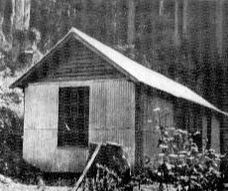
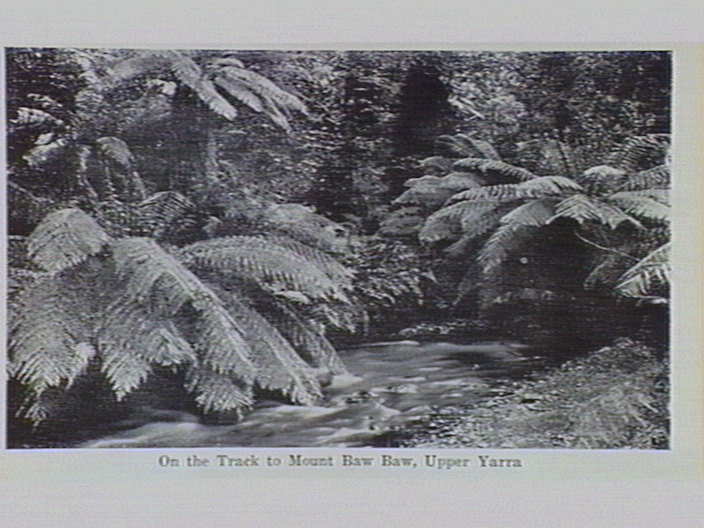
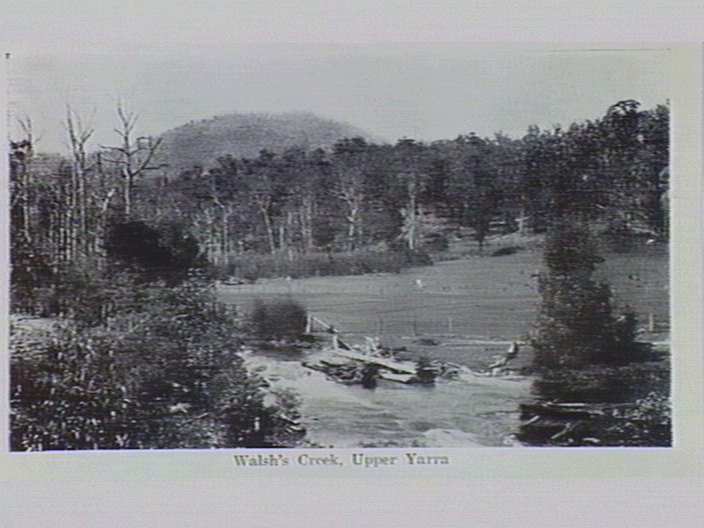
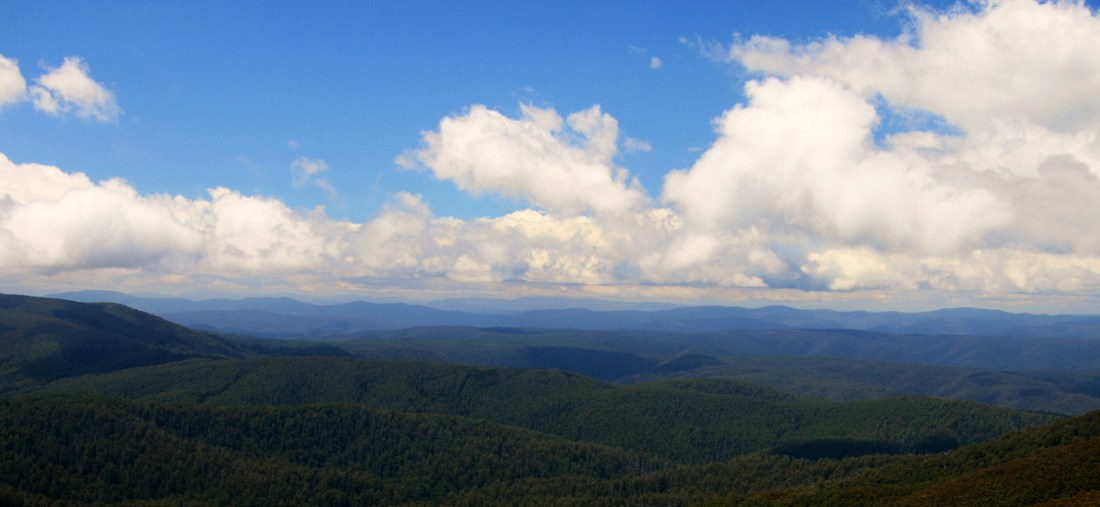


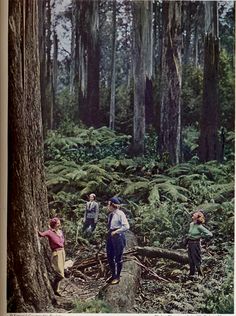
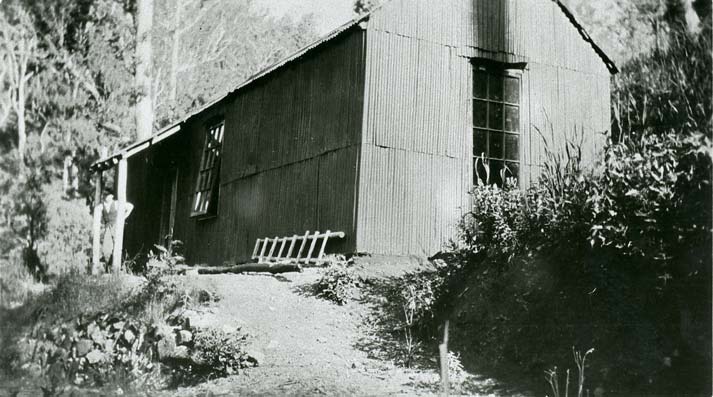
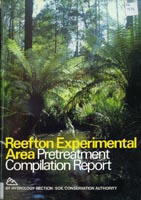

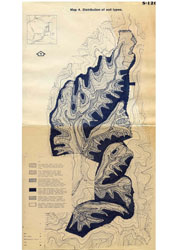


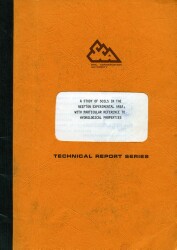
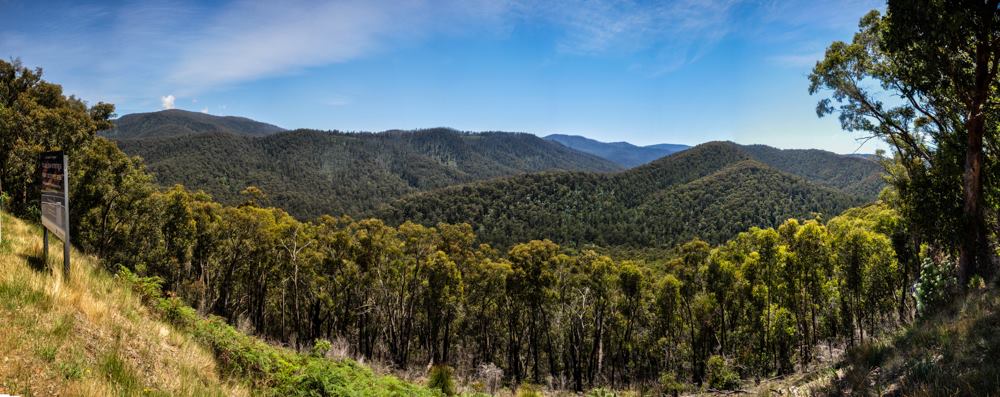
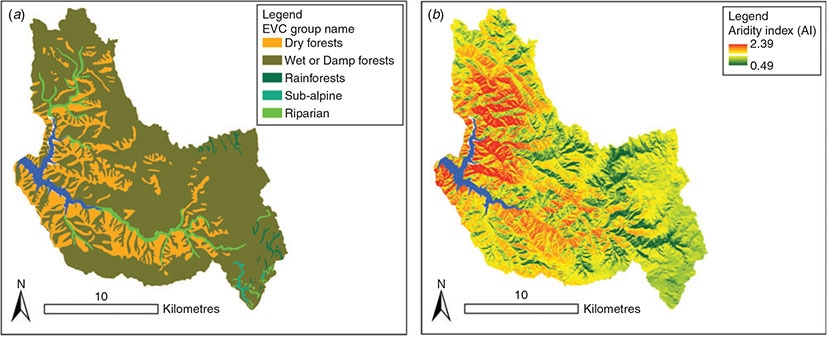
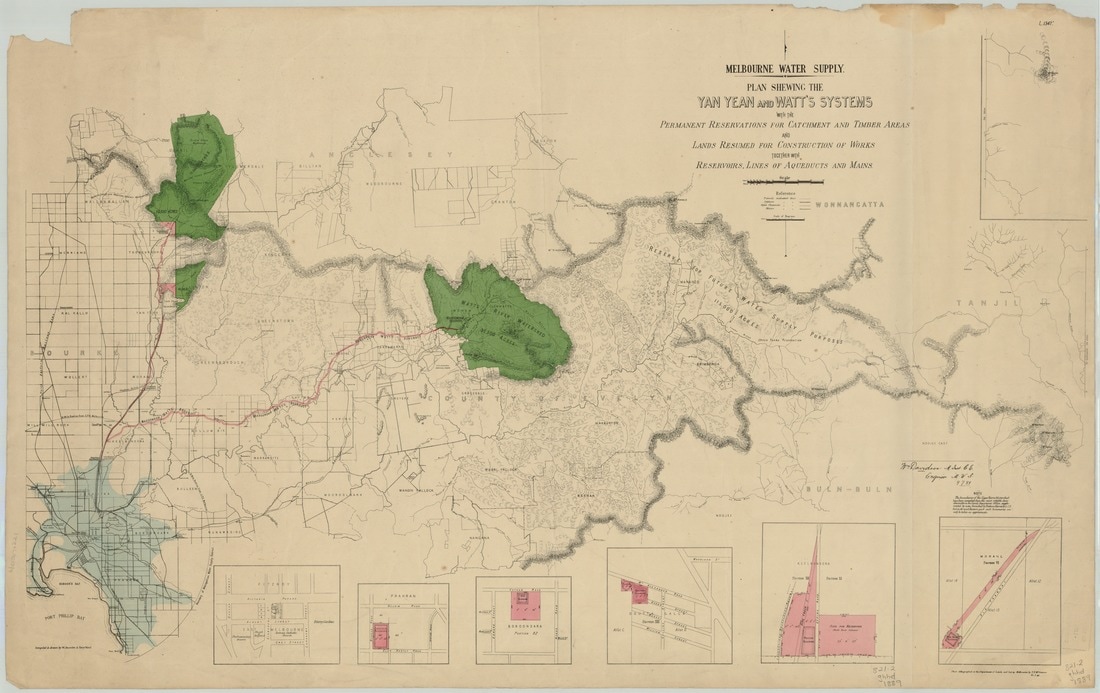
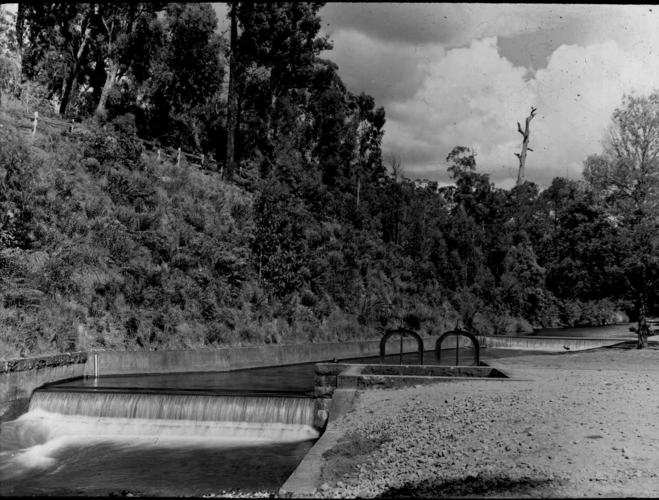
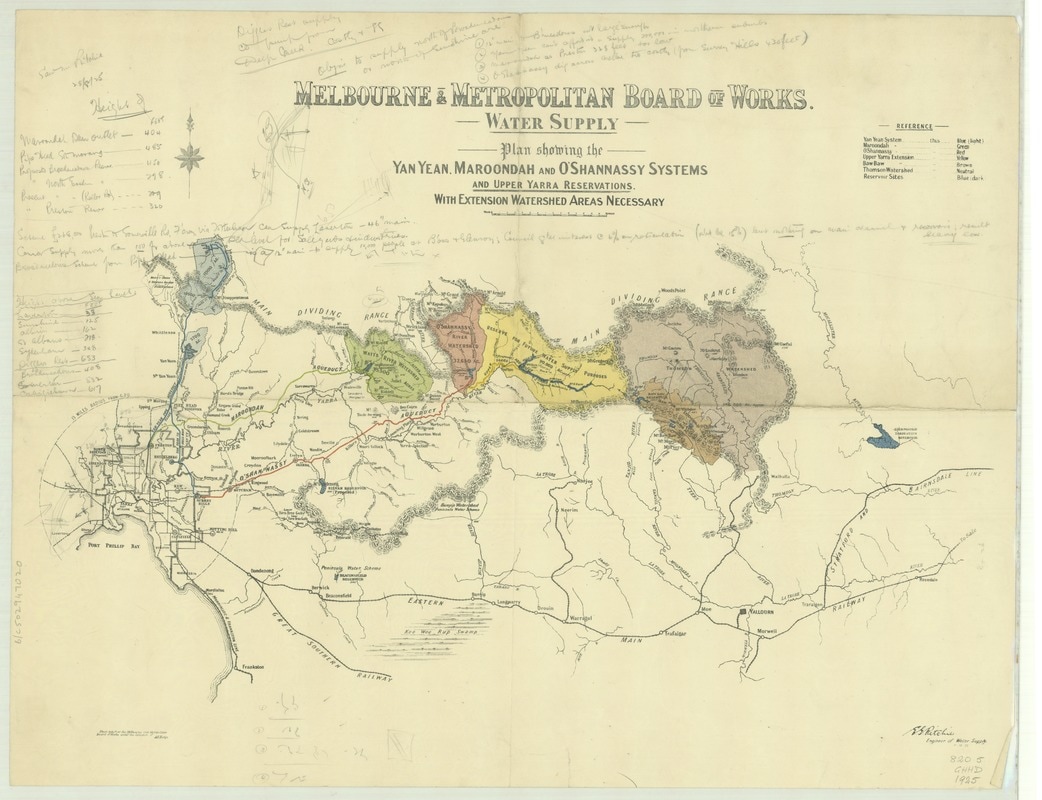


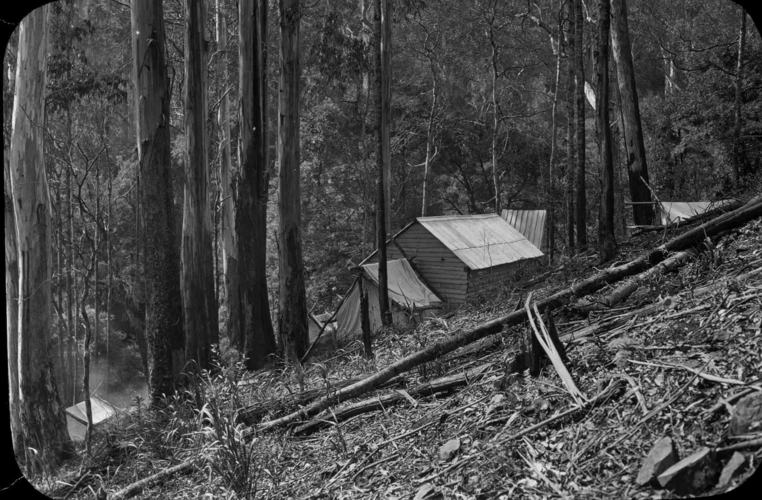

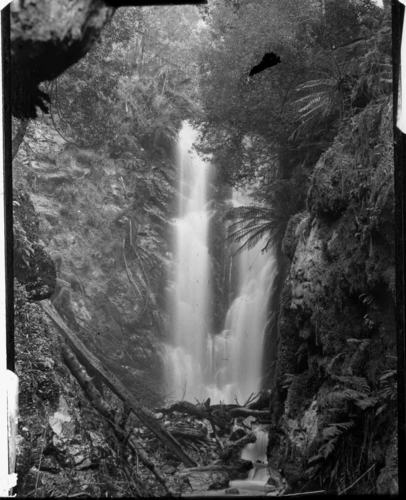


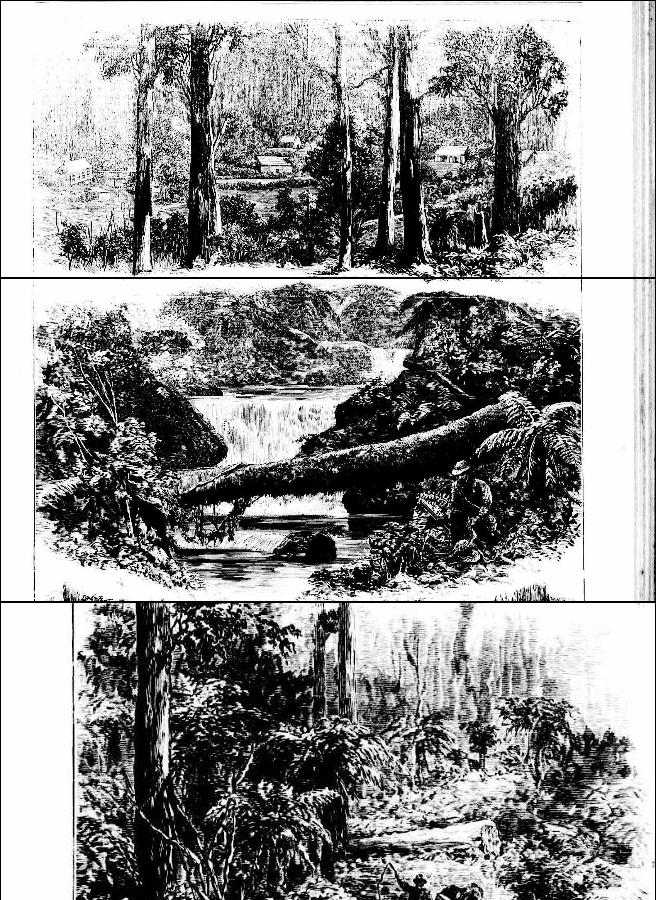
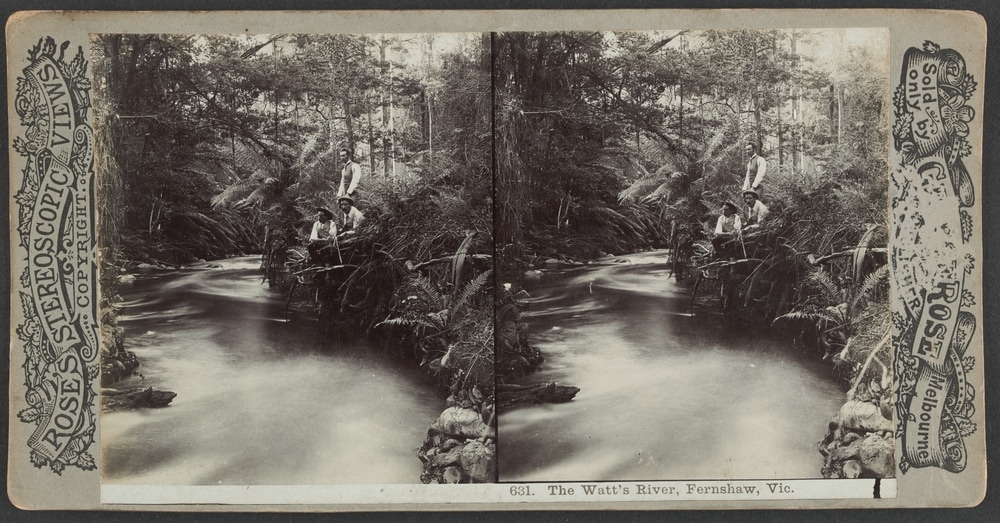
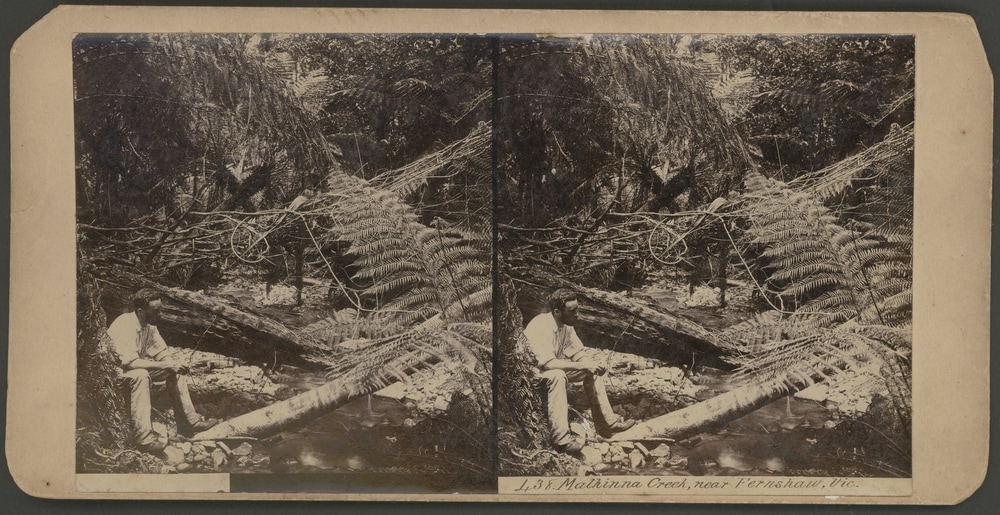
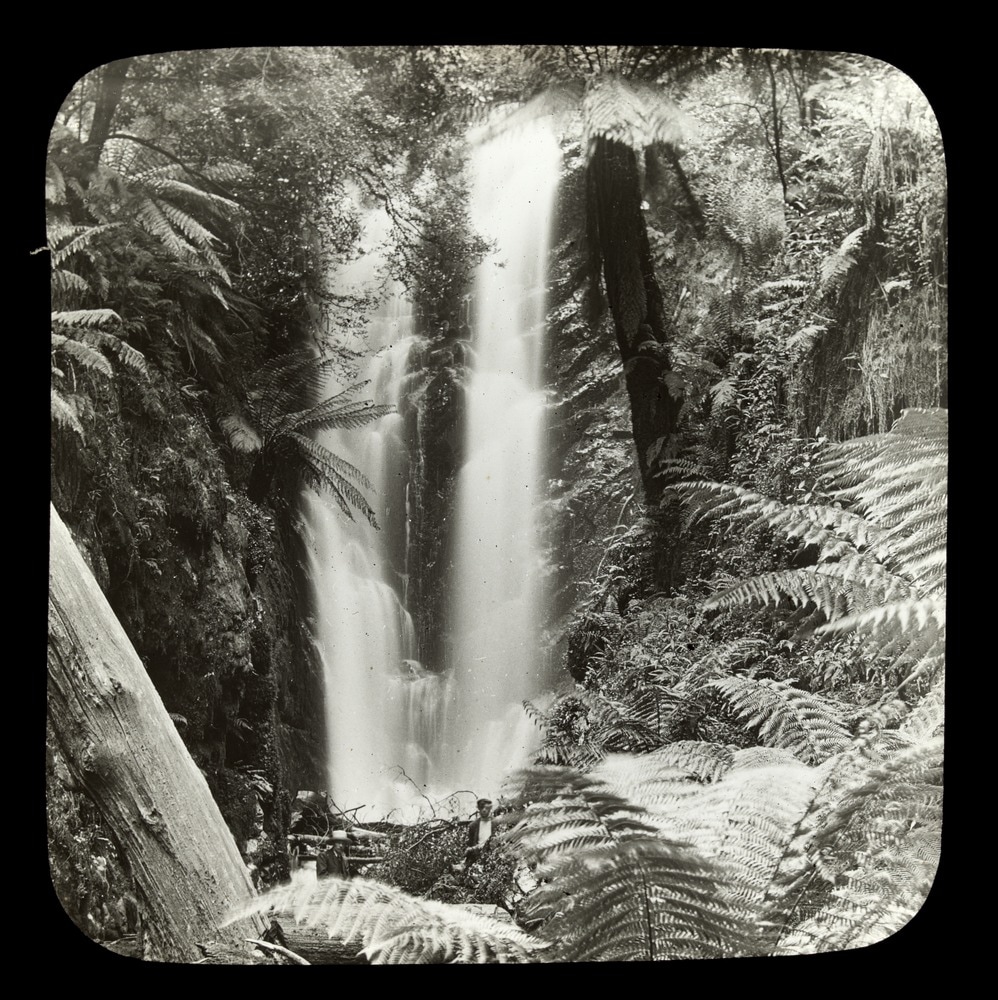


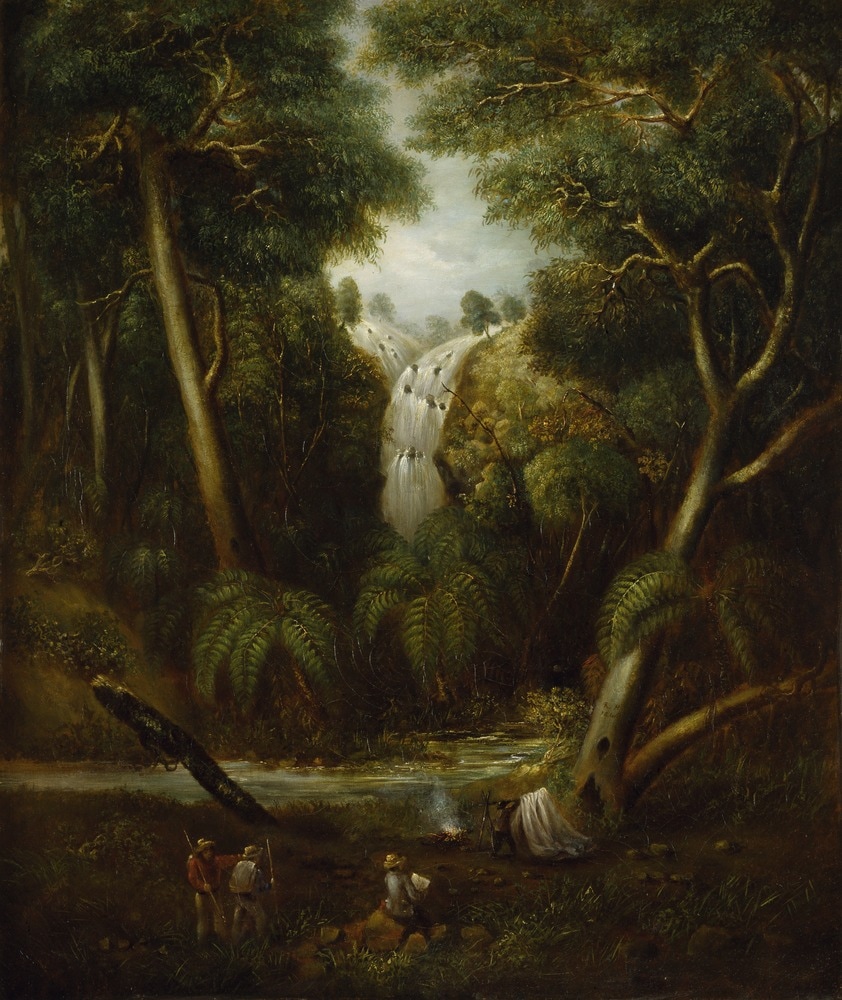






 RSS Feed
RSS Feed
